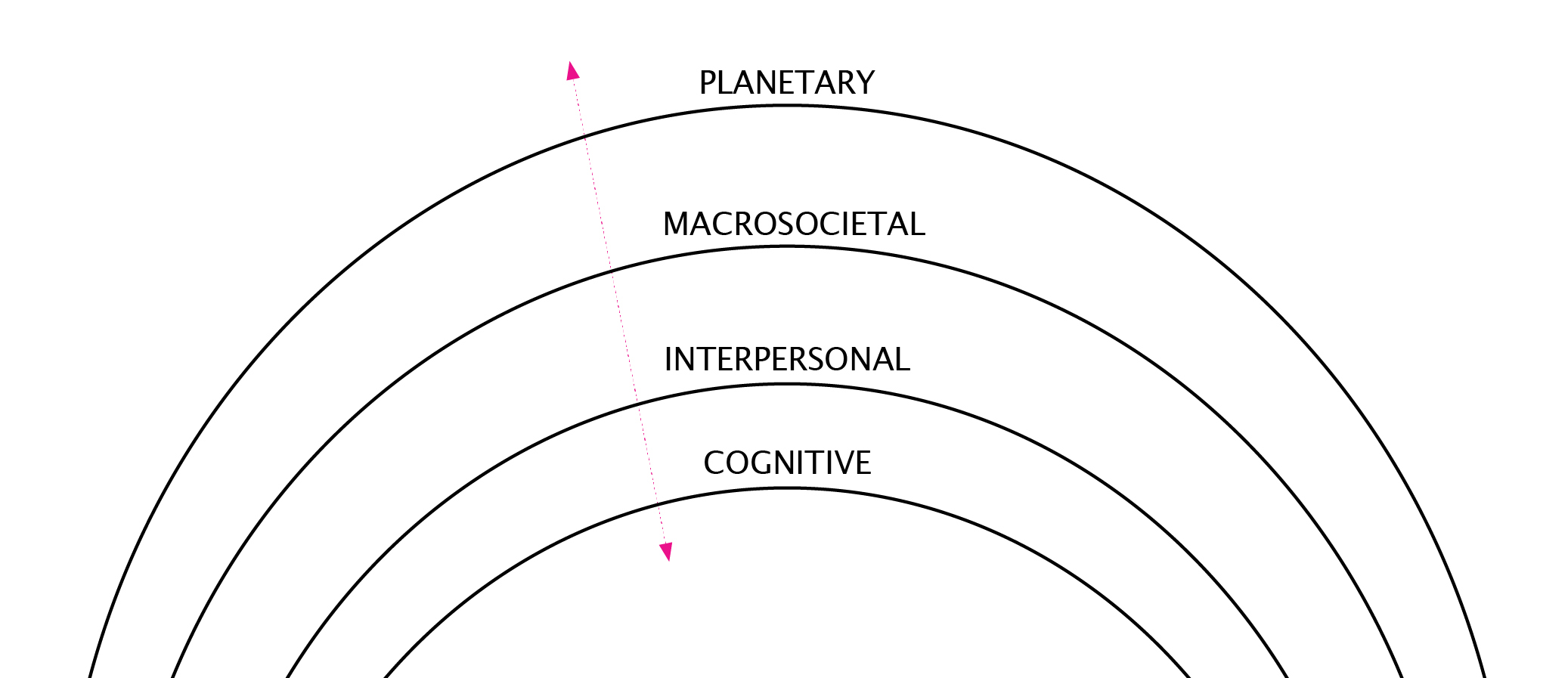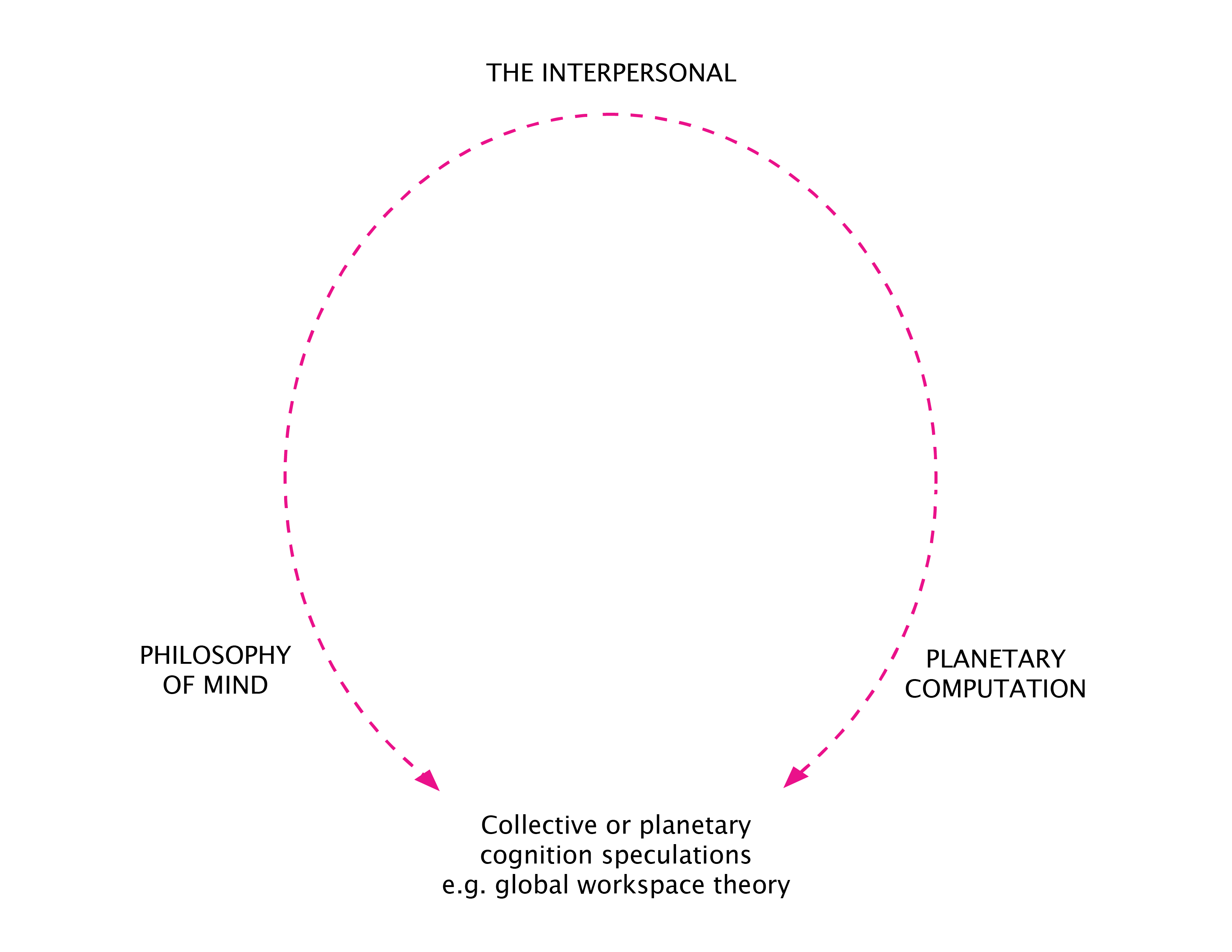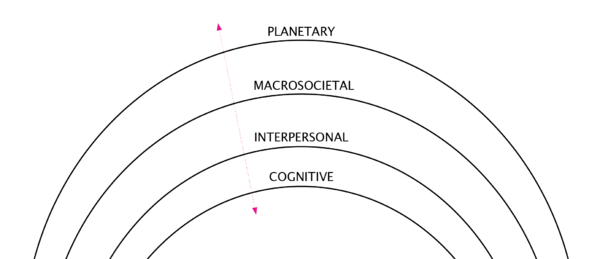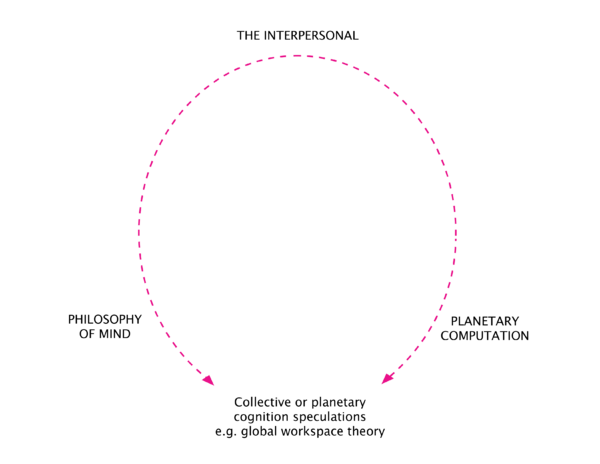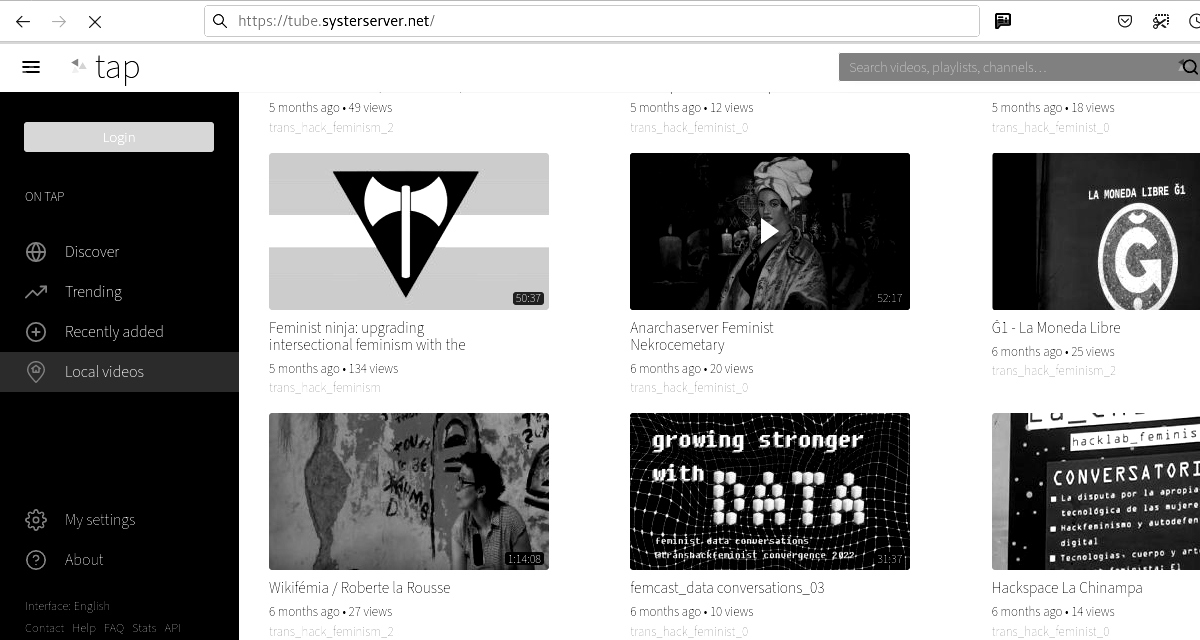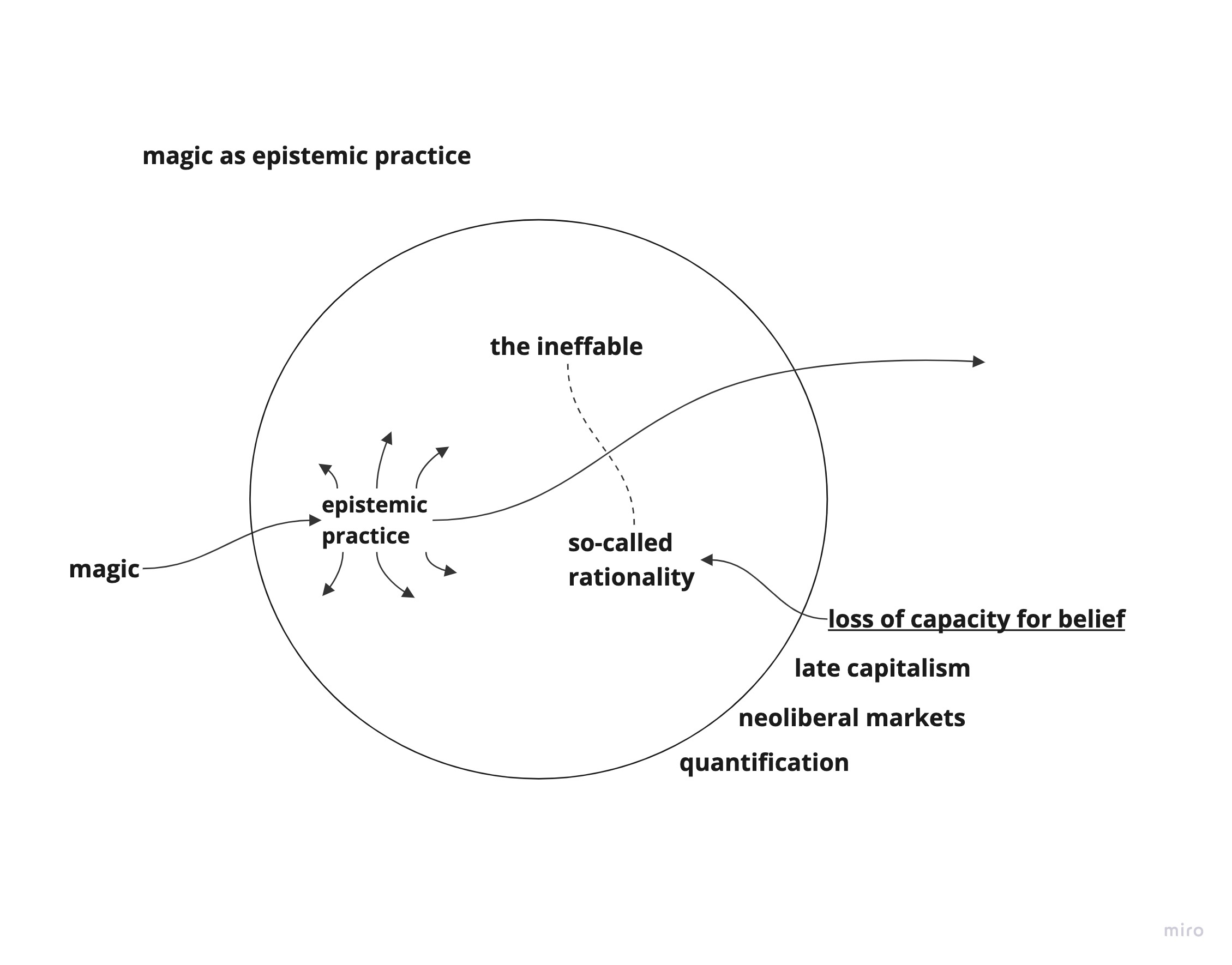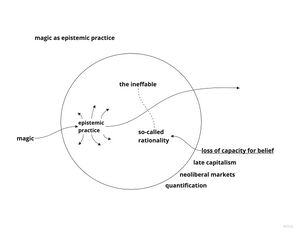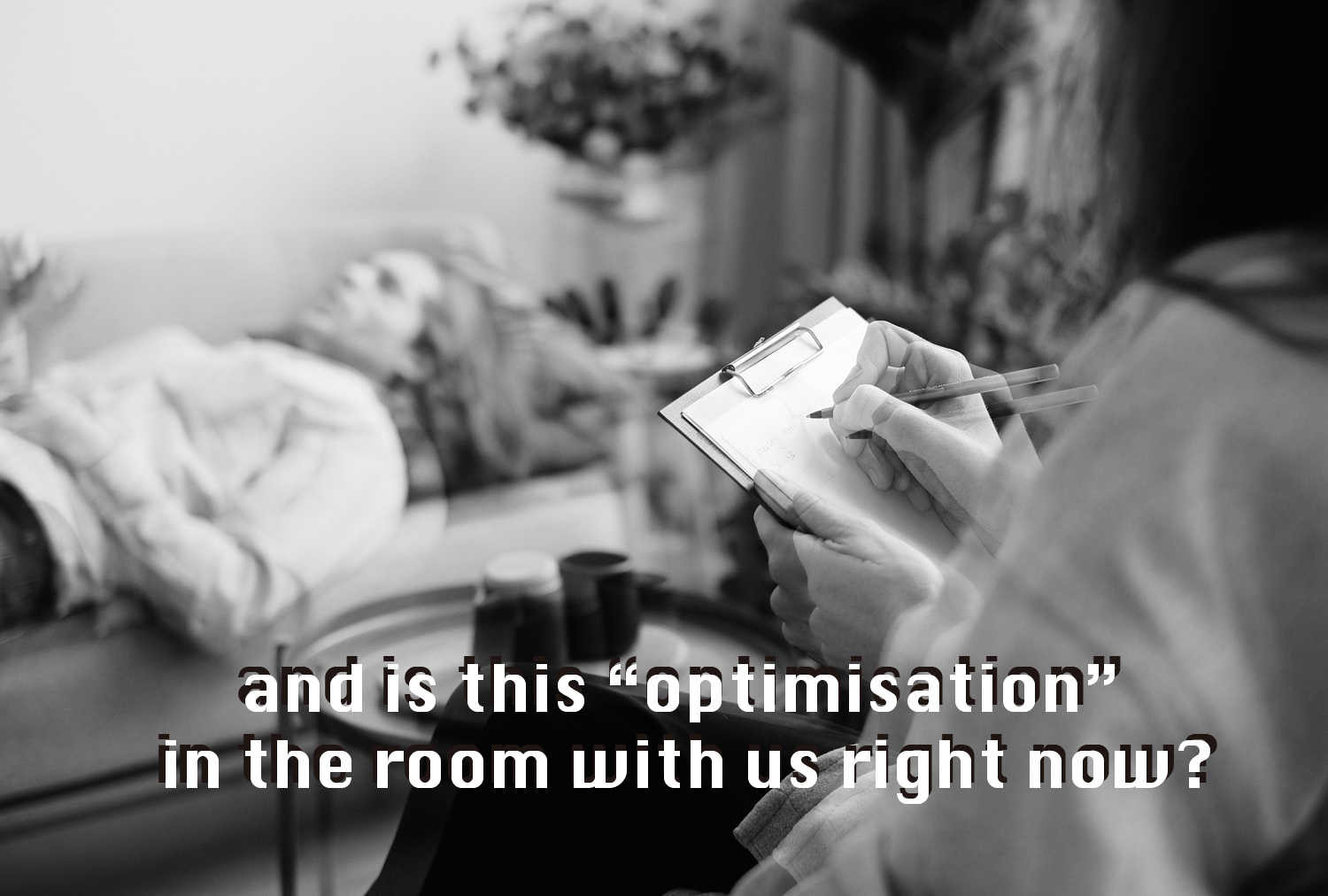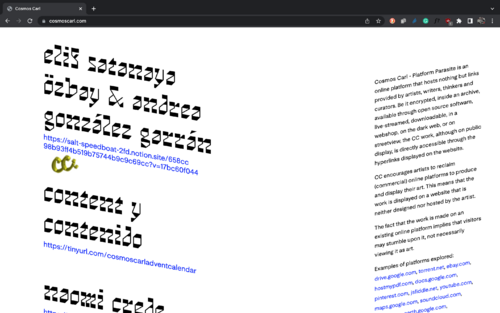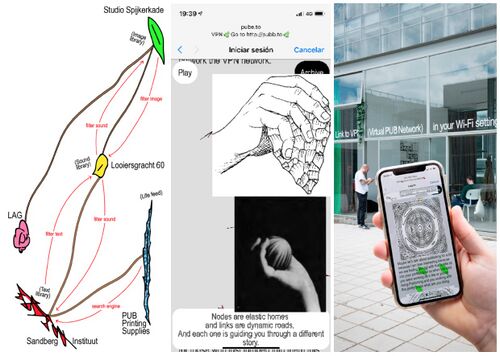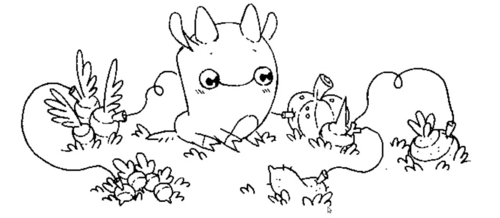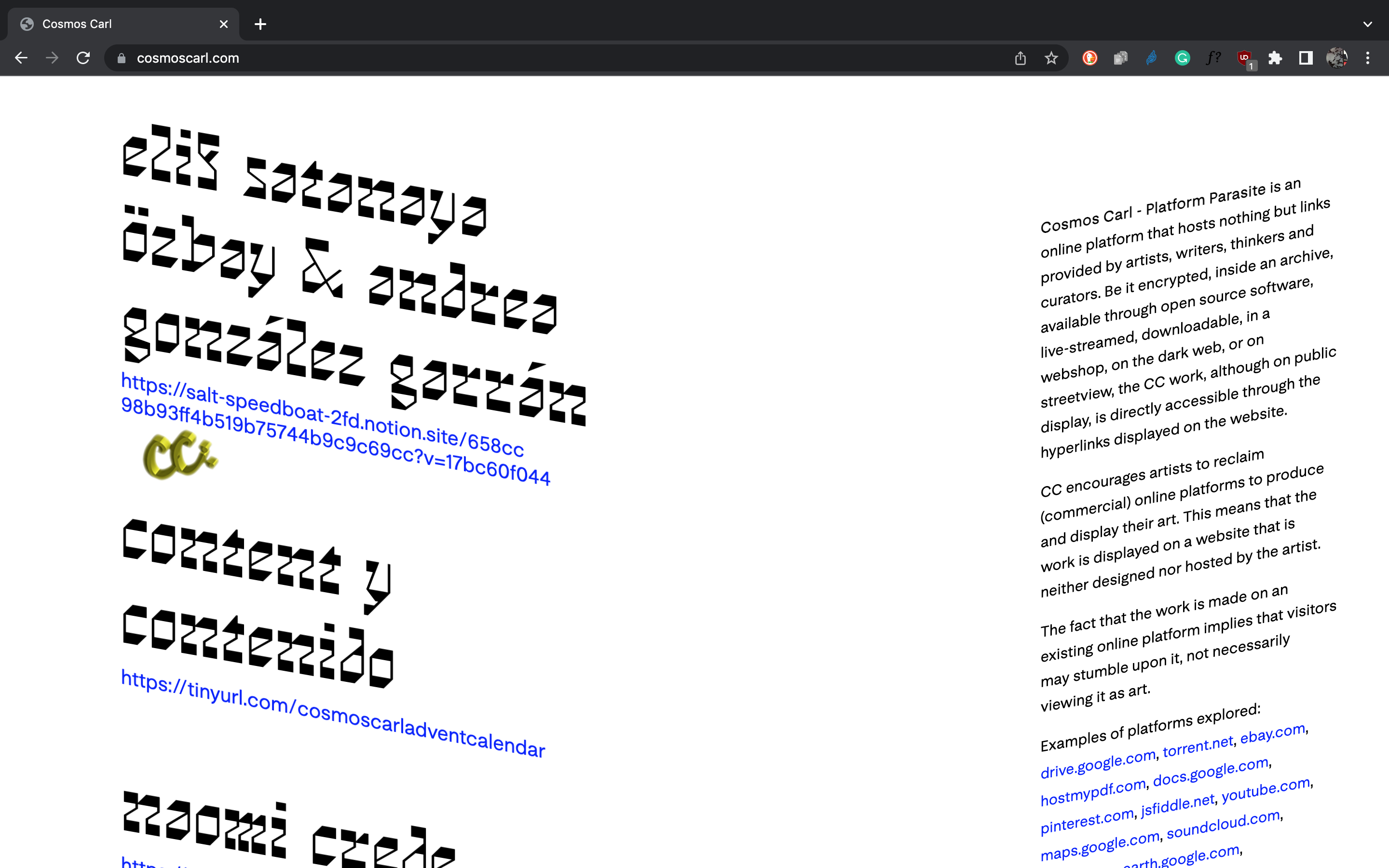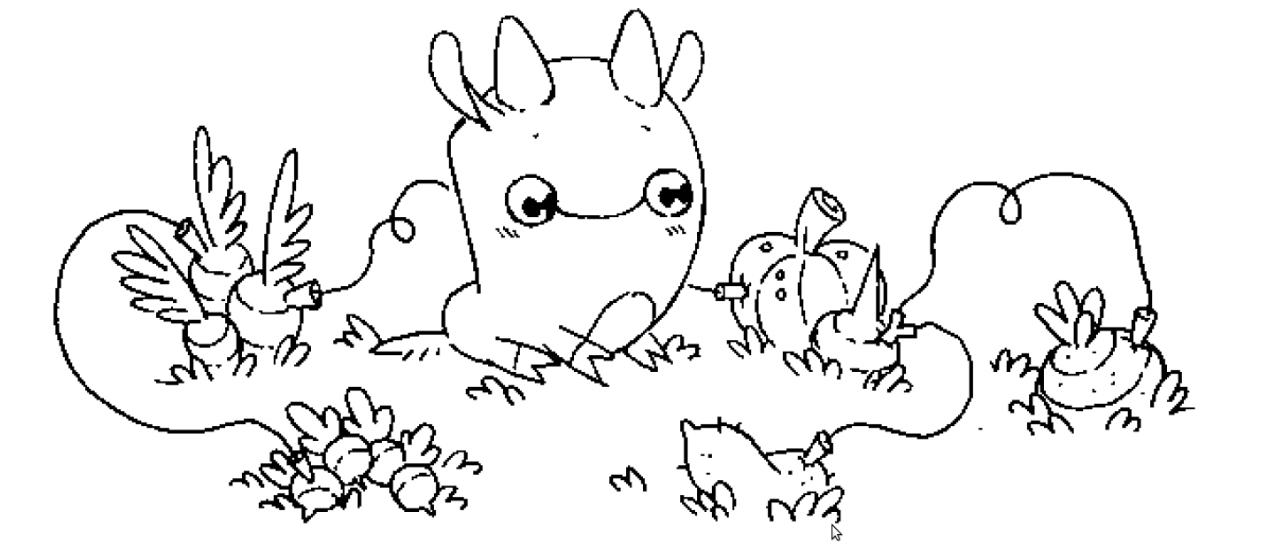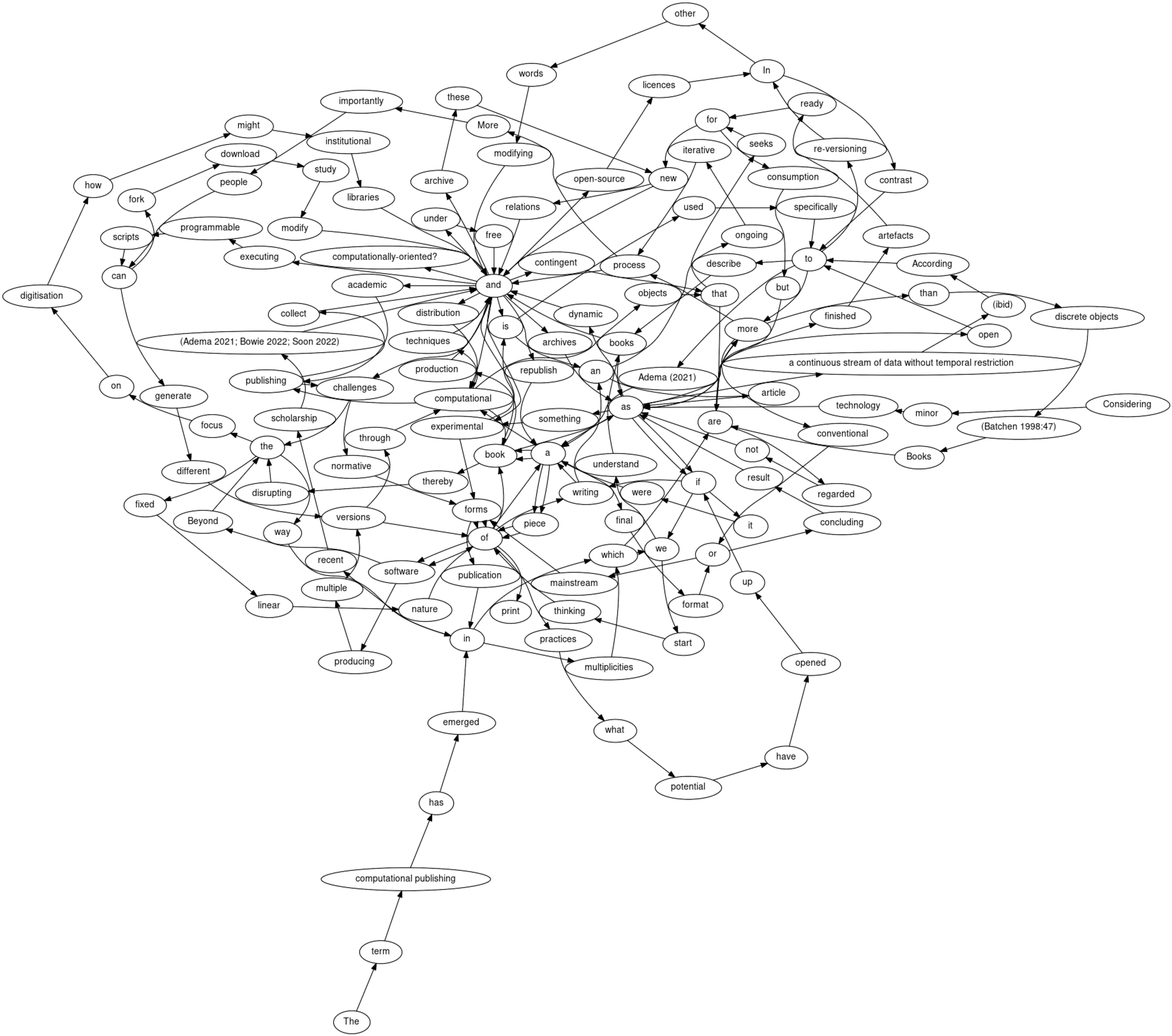Pdf:Toward a Minor Tech: Difference between revisions
No edit summary |
No edit summary |
||
| Line 31: | Line 31: | ||
<div class="item cellular" id="cellular-1"> | <div class="item cellular" id="cellular-1"> | ||
{{ Toward a Minor Tech:HermeticKnowledge }} | {{ Toward a Minor Tech:HermeticKnowledge }} | ||
</div> | |||
<div class="item font-inria-serif" id="colophon"> | |||
'''Colophon''' | |||
{{ Toward_a_Minor Tech:Colophon }} | |||
</div> | </div> | ||
| Line 226: | Line 231: | ||
{{ Toward a Minor Tech:Shared bibliography }} | {{ Toward a Minor Tech:Shared bibliography }} | ||
</div> | </div> | ||
</div> | </div> | ||
Revision as of 17:17, 22 January 2023
Toward a Minor Tech
Toward a Minor Tech
Christian Ulrik Andersen & Geoff Cox
The three characteristics of minor literature are the deterritorialization of language, the connection of the individual to a political immediacy, and the collective arrangement of utterance. Which amounts to this: that “minor” no longer characterises certain literatures, but describes the revolutionary conditions of any literature within what we call the great (or established).
–– Deleuze and Guattari, “Kafka: Toward a Minor Literature”
The 2023 edition of transmediale explores “how technological scale sets conditions for relations, feelings, democratic processes, and infrastructures.” (https://2023.transmediale.de/). This becomes apparent in the massification of images and texts, and the application of various scalar machine techniques that try to make these comprehensible for human and non-human readers.“There is a problem with scale”, as Anna Tsing puts it, in its connection to modernist master narratives that organise life on an increasingly globalised scale (the “bigness” of capitalism). Instead, she writes, we need to “notice” the small details and not assume that these need to be scaled up to be effective. In technical fields, there is a similar problem with scale, as Big Tech dominates, with ensuing environmental damage; big computing begets big data.
Following a process of open exchanges and a three-day research workshop in London, at LSBU and KCL, this publication brings together researchers who address the problems of technological scale, thinking through the potentials of 'the minor'; or what we are referring to as minor (or minority) tech – small tech that operates at human scale (more peer to peer than server-client) and stutters in its expression and application. As Marloes de Valk puts it in the Damaged Earth Catalog: “Small technology, smallnet and smolnet are associated with communities using alternative network infrastructures, delinking from the commercial Internet.” As such, the publication sets out to question the universal ideals of technology and its problems of scale, extending it to follow the three main characteristics identified in Deleuze and Guattari's essay, namely deterritorialization, political immediacy, and collective value.
Together authors address minor tech through its relation to big data, machine learning, artificial intelligence, cloud computing, blockchain mining, art worlds, global organisation of labour, extractions of natural resources, exploitation, energy consumption, trans-feminisms and decoloniality. Further issues that arise question, for instance, the dynamics between big data and small technology, attentive to what Cathy Park Hong calls “minor feelings” (that derive from racial and economic discrimination in society); how to bring together new material and minor cultural assemblages between humans and nonhumans, ecology, and technological infrastructure and systems; or, how this relates to minor practices and collective action.
This publication includes short articles that were written during the workshop and as a result of extensive peer exchange, and will be extended in the next issue of APRJA (http://aprja.net) to be published Summer 2023.
At the workshop, the authors and editors of this publication were joined by Marloes de Valk, Elena Marchevska, Tung-Hui Hu (at The Photographers' Gallery), and Manetta Berends & Simon Browne (Varia). The workshop and publication were supported by CSNI (London South Bank University), and SHAPE Digital Citizenship and Graduate School Arts (Aarhus University).
Scaling Up, Scaling Down: Racialism in the Age of ‘Big Data’
Scaling Up, Scaling Down: Racialism in the Age of ‘Big Data’
Camille Crichlow
Breaking the surface of skin and enveloping the racial body politic in ever-minute scales of perceptual closeness, the genomic revolution of the 1990’s gestured toward racialism’s still potential demise: the end of race itself. As older conceptions of race explicitly tied to anatomical scales of the body were belied by a breakthrough consensus – that race has no fundamental basis in human biology – the perceptual regimes to which racialism was attached were, as sociologist Paul Gilroy claims, ambivalently undone (1998).
In the context of 21st century digital processing, another break in racial scale has emerged. There is a sense that race is being remade not within extant contours of the body’s visibility, but outside corporeal recognition altogether. Predictive policing, for example, increasingly relies on an accumulation of data to construct zones of suspicion through which the racial body is interrogated (Brayne 2020; Chun 2021). While racial categories are not explicitly coded within the classificatory techniques of analytic technologies, large-scale automated data processing condense and map racialising outputs that, without critical interrogation, appear neutral. Thao Than and Scott Wark define these algorithmically generated racial formations as ‘data formations’: “modes of classification that operate through proxies and abstractions and that figure racialized bodies not as single, coherent subjects, but as shifting clusters of data” (1, 2020).
As large-scale automated data processing reproduces patterns of racialisation indiscernible to the human eye, the question of scale has again become relevant to a post-visual discourse of race. What if the historical compression of racial scale—a movement of race-craft inwards and downwards into the minute and microscopic signifiers of the body — now exerts upwards and outwards pressures into a globalised regime of datafication? In other words, how is racial epistemology reproduced, reconstructed, and reified within the scalar magnitude of ‘big data’? These questions are not to suggest that racialism as it has been historically constituted is being dismantled by the grand scale of computational processing; or that other modes of racialist discourse are not still firmly rooted within material experience. Rather, I reference the loosening of race from the grips of not only ocular modes of seeing, but perceptual regimes of racial scale, whereby race category is not only assigned to the small-scall signifiers of the body, but inferred through large-scale algorithmic correlation, categorisation, and abstraction of data. While racialisation and data have always been constitutive (Womack 2021; Zuberi 2001), the scale of ‘big data’ mask an insidious realignment whereby race seems to disappear, while its effects are more deeply inscribed within lived experience.
Yet, racialisation is not overdetermined by large-scale automated data processing. Beyond ‘opting out’ of data regimes or obfuscating oneself from surveillance apparatuses, possibilities of transfiguration that refuse racialising and colonialist ‘data relations’ remain conceivable (Couldry and Mejias). This begins with refusing the absolute neutrality that ‘big data’ regimes attempt to guarantee. How might ‘big’ and ‘small’ tech be mobilised towards liberatory practices of refusal that challenge scalar realignments of racialism, and transform domains of experience toward an end of race futurity?
Rendering Minor Worlds
Rendering Minor Worlds
Teodora Sinziana Fartan
Critical renderings of speculative virtual imaginaries are increasingly emerging today as a form of collective utterance, a minority language that responds to the current states of emergency that we find ourselves in socially, politically, ecologically and technologically. The recent crystallization of immersive worlding as an experiential storytelling practice situates itself within the political context of resistance through its search for modes of being-otherwise. Kafka writes of literature that it should “affect us like a disaster, that grieves us deeply, like the death of someone we loved more than ourselves, like being banished into forests far from everyone”, foregrounding the affective and transformative power of storytelling - stretching forwards from his time to the present day, we see this practice of critical storytelling extended into the realm of virtual ecologies with artists like Ian Cheng, Lawrence Lek, David Blandy and Larry Achiampong, Sahej Rahal and Keiken formulating critiques of our contemporary context by producing minor worlds that speculatively explore alternative narratives. As Stengers urges us, these practices attempt to imagine “connections with new powers of acting, feeling, imagining, and thinking” and then prototype, hack, develop and render these into being.
A question, therefore emerges: how can we position and conceptualize these novel modes of expression that operate within the scales of virtual game spaces and their underlying networks of exchange? How can practices of worlding enable us to abandon “habitual temporalities and modes of being”, as Helen Palmer puts it, and think beyond ourselves, speculatively, towards possible futures and fictions?
The turn towards immersive world design is enabled by the recent deployment of game engine technologies towards critical digital experimentation, enabling artists to produce increasingly complex digital artifacts. Similarly to the properties of a minor language formulated by Deleuze and Guattari in their analysis of Kafka’s writing, today’s turn towards the production of virtual worlds as sites of alternative possibilities is deterritorializing the existing entertainment-centric and economically-driven mode of existence of immersive game productions. Within the parameters of the game engine itself, the various features, interfaces and functionalities of mainstream game design software are geared towards competitive ludic productions. However, with the increased accessibility of gaming technologies, we see the emergence of collective efforts to utilize game engines critically, towards the production of minority worlds, where the entertainment-focused properties of commodified games are replaced with experimental assemblages and their affect constellations.
When the majority language of the game engine is deployed into the minor territories of experiment and social critique, the audience's connection to political immediacy is facilitated through the experimental readings that are enabled. Pushing beyond the transformation of given content into the appropriate forms expected of major literature, worlding moves into the territory of minority expressions, where experimental and non-linear formats operate in networked and multifaceted ways, “speaking first and only conceiving afterwards”, as McLean infers. This study, therefore, aims to trace the ways in which new openings into alternative imaginaries are made possible on the shores of virtual worlds: how do virtual ecologies allow for new ways of being and knowing? And through these new modes of existence, how can worlding promote a state of community and becoming, foregrounding active solidarities?
The Digital Pastoral: a Minor Critique of Minor Tech
The Digital Pastoral: a Minor Critique of Minor Tech
Daniel Chávez Heras
Minor tech, with its nod to minor literature, reminds of Wendell Berry’s reluctance to buy a computer in the late 1980s. Bemoaning digital technologies increasing dependence on strip-mined coal, Berry wrote “How could I write conscientiously against the rape of nature if I were, in the act of writing, implicated in the rape?” and went to to defend his writing on a mechanical typewriter and only during the daytime. He also prescribed a list of injunctions to evaluate technological innovation, including that proposed new technologies ought to be cheaper, at least as small in scale and consume less energy than their predecessors, be repairable, and not disturb community relations.
These prescriptions deeply echo some of today’s criticisms about big or “major” tech, with its supranational powers, polluting data centres, opaque corporate governance, and profound and often nefarious influence in social relations. Take for example Anna Tsing’s critique of scale and scalability, a version of which has been picked up by cooperative, community-driven, horizontal, decentralised, federated, initiatives that “resist scale” as a deliberate counterpoint to corporate big tech; from feminist servers to the Small File Photo Festival which questions the “endless growth of higher and higher resolutions”.
Though I share many of the concerns posed by the unchecked corporate takeover of digital technologies, and I am sympathetic too to the political dimensions of these arguments, I am less persuaded by their proponent’s tactical choices and concrete instantiations of what I would call, in reference to Berry, the digital pastoral. To stick with scalability, for example, it seems to me that it is a feature of technological systems that can be more easily resisted when one is thinking about art festivals and niche online communities, and not so much when we think about the global systems that regulate networked communications upon which millions of people depend everyday. I am not convinced that non-scalable technologies are the best way to address the needs of the global south, with its vast populations and very large, very pressing, problems. Intuitively, I tend to believe that the vast majority of the world cannot afford not to think at scale on the face of the systemic threats that beset the planet and our collective survival in it.
I am sceptical about minor tech for many of the same reasons I am sceptical of Berry’s arguments. I think he fundamentally misunderstands the nature of technological innovation, and its and in following these injunctions minor tech risks misunderstanding how many people already depend on large-scale systems ―systems that that certainly can and ought to work better, more fairly, and more democratically, but probably will not and should not cease to exist. We might not like our dependence on these systems, and individually we might even be able to retreat from them, but I would caution not confuse this desire for individual emancipation with our collective responsibility to the many who cannot afford to resist scale. The issue for me is not how to avoid scale, but rather how and who decides what to scale and how. This is, I want to clarify, a hopeful scepticism. One aspect that I like about minor tech and that makes me optimistic about its future is that in its very definition there is potential: it does not have to stay minor; it might come of age and perhaps come to enact some of its poignant and otherwise intellectually rich criticisms in broader social arenas; heck, some of it might in fact scale much better than we originally thought!
The minor vocabularies of conspiracy theories, crypto, and other forms of secular magic trade in the promises of hermetic knowledge. Feelings of accessing another reality might rather be the effects of producing it by segregating those who are in from those who are out.
Colophon A Peer-reviewed Newspaper
Volume 12, Issue 1, 2023.
Edited by all authors
Published by Digital Aesthetics Research Center, Aarhus University
Organised in collaboration with Centre for the Study of the Networked Image, London South Bank University; King's College, London; transmediale, Berlin; Film & Media/FAS, Queen's University; and Varia, Rotterdam.
The publication was generated with wiki-to-print hosted on Creative Crowd, by Varia.
Publishing licence: CC4r - https://constantvzw.org/wefts/cc4r.en.html
Printing: Drukkerij Tripiti, Rotterdam. Printed in an edition of 2000 copies.
Design: Manetta Berends & Simon Browne (Varia) https://varia.zone
Fonts: All fonts used in this newspaper are published freely under the SIL Open Font License: https://scripts.sil.org/OFL, apart from Authentic Sans, which is published under the WTFPL: http://www.wtfpl.net/
- Authentic Sans
- Computer Modern
- Degheest Types
- Junicode Condensed
- Latitude
- Lucette
- Redaction
ISSN: 2245-7593 (Print)
ISSN: 2245-7607 (PDF)
Contributors
Christian Ulrik Andersen, Digital Aesthetics Research Center, Aarhus University, is attempting to bring the knowledge and practices of digital culture and art to the fore.
Geoff Cox is Professor of Art and Computational Culture at London South Bank University, and co-director of Centre for the Study of the Networked Image (CSNI), working across software studies and contemporary aesthetics.
Camille Crichlow is a PhD Researcher at the Sarah Parker Remond Centre for the Study of Racism and Racialisation (University College London). Her research interrogates how the historical and socio-cultural narrative of race manifests in contemporary algorithmic technologies.
Mateus Domingos is an artist and MRes researcher at CSNI, London South Bank University.
From a network of Feminist Servers the following authors contributed: mara karagianni - artist, software developer, sysadmin, ooooo - Transuniversal constellation, nate wessalowski - PhD student at Münster University, vo ezn - sound && infrastructure artist.
Teodora Sinziana Fartan is an artist and PhD researcher at CSNI, London South Bank University.
Susanne Förster is a PhD candidate and research associate at the University of Siegen. Her work deals with imaginaries and infrastructures of conversational artificial agents.
Inte Gloerich (Utrecht University & Institute of Network Cultures) researches sociotechnical imaginaries around blockchain technology as they appear in for instance memes, startup culture, and art.
Daniel Chávez Heras is Lecturer in Digital Culture and Creative Computing at King's College London. He studies the computational production and analysis of visual culture.
Macon Holt is a a Post-Doctoral researcher at Copenhagen Business School. He is author of 'Pop Muisc and Hip Ennui. A Sonic Fiction of Capitalist Realism' (Bloomsbury, 2020).
Jung-Ah Kim is a PhD researcher in Screen Cultures and Curatorial Studies at Queen’s University. She studies the relationship between weaving and computing and traditional Korean textiles.
Edoardo Lomi is a PhD Fellow at Copenhagen Business School. His project focuses on the palliative care of digital infrastructures.
Inga Luchs is a PhD candidate at the University of Groningen. In her research, she deals with questions of data classification and discrimination from a cultural and technical perspective.
Gabriel Menotti is Associate Professor in Film & Media at Queen's University and an independent curator, and co-cordinates the Besides the Screen network.
Alasdair Milne is a PhD researcher with Serpentine Galleries’ Creative AI Lab and King’s College London. His work focuses on the collaborative systems that emerge around new technologies.
Anna Mladentseva is a PhD researcher at University College London whose project focuses on the conservation of software-based works of art and design from the Victoria & Albert museum.
Shusha Niederberger is a PhD researcher based at Zurich University of the Arts and working on user subject positions in datafied environments and aesthetic strategies of using otherwise.
Søren Bro Pold Digital Aesthetics Research Center, Aarhus University, works with the arts of the interface and interface criticism.
Roel Roscam Abbing is a PhD researcher in Interaction Design at Malmö University's School of Arts and Communication. There he studies alternative and federated social media systems.
Winnie Soon is a Hong Kong-born artist coder and researcher, engaging with themes such as Free and Open Source Culture, Coding Otherwise, artistic/technical manuals and digital censorship.
Magdalena Tyżlik-Carver ferments data and investigates Critical Data and related practices through curating. She is Associate Professor in Digital Design and Information Studies at Aarhus University.
Varia is a space for developing collective approaches to everyday technology. https://varia.zone
Jack Wilson is a PhD researcher at the University of Warwick’s Centre for Interdisciplinary Methodologies. He is not a conspiracy theorist.
xenodata co-operative investigates image politics, algorithmic culture and technological conditions of knowledge production and governance through art and media practices. The collective is run by curator Yasemin Keskintepe and artist-researcher Alexandra (Sasha) Anikina.
Sandy Di Yu is a PhD researcher at the University of Sussex and co-managing editor of DiSCo Journal (www.discojournal.com), using digital artist critique to examine shifting experiences of time.
Freja Kir is researching across intersections of artistic methods, spatial publishing and digital media environments. Creatively directing fanfare – collective for visual communication. Contributing to stanza – studio for critical publishing. PhD researcher, University of West London.
Minor Tech, Major Problem: QAnon’s Scales
Minor Tech, Major Problem: QAnon’s Scales
Jack Wilson
From its imaginary – that spans thousands of years and encompasses near-all contemporary and historical conspiracy theories – to the horde that overwhelmed the US Capitol on the 6th of January 2020, discourses on the topic of the far-right phenomenon known as ‘QAnon’ are characterised by an immensity of scale. Such an emphasis on the aggregate size of the phenomenon suggests that it is a commensurately massive product of what this publication terms ‘major tech.’
Although QAnon is implicated in enormous societal upheaval for which the techno-social infrastructures of major tech have had an undeniable role, the contemporary salience of QAnon cannot be understood as wholly a result of these forces. Rather, QAnon is best understood as an assemblage ‘minor techs’: small-scale and contrarian practices and infrastructures whose granularity produces the conditions for the aggregation that we know as ‘QAnon.’
Here, the term: ‘do your own research’ is instructive. Among the myriad and often opposed factions of QAnon the injunction to ‘do your own research’ is a shared refrain that characterises participation in QAnon as not simply a matter of belief, but as the (by implication, inevitable) result of the individual establishing the alleged veracity of the phenomenon’s imaginary for themselves.
Said ‘research’ is largely oriented around the interpretation of events in the world with reference to the cryptic dispatches of the anonymous figure ‘Q’ (called ‘Q Drops’) which form the ur-text of the phenomenon. Per Q (in Drop 4550):Rather than being a prophet bearing a revealed truth (and therefore risk reproducing the hierarchies that are seen to characterise the hegemonic episteme), Q is characterised as training participants in a way of seeing. Namely, a way of seeing that takes the contingencies that produced the present and scales them down into a format that is compatible with QAnon's conspiratorial worldview. At the same time, the Q Drops themselves are mined by participants for signification at the increasingly molecular scales: of language, data, and meta-data (actual and esoteric) to the point of (but, notably, never reaching) exhaustion.You are being presented with the gift of vision.
Ability to see [clearly] what they've hid from you for so long [illumination].
Their deception [dark actions] on full display.
People are waking up in mass.
People are no longer blind.
Given these materials being originally posted exclusively to the anarchic and unarchived image boards of 4chan and 8kun (née ‘8chan’), such efforts would be extremely difficult if not for the variety of Q drop aggregators that have emerged to allow ‘research’ to take place. QAnon.pub, QMap, QAgg – these QAnon participant-built and maintained infrastructures provide the conditions for the extremely granular analysis of Q Drops at the scale of countless individual ‘researchers.’ The confluence of these minor tech infrastructures (the archives) and strategies (‘do your own research’) create the conditions from which the aggregation understood to be ‘QAnon’ emerged. Addressing the problem of QAnon therefore requires grappling with its scales, and moreover: and awareness that minor is not necessarily always ‘good.’
Small Talk: About the Size of Language Models
Small Talk: About the Size of Language Models
Susanne Förster
Large language models are based on the promise that the larger the underlying data set, the better the performance. This development is particularly related to the Transformer Network architecture, which was introduced by Google in 2017 and is used in GPT-3 and other leading large language models.
Many critical researchers have pointed out how the composition of training data has resulted in the reproduction of societal biases. Crawled from the Internet, the data and thus the generated language mainly represents hegemonic identities whilst discriminating against marginalized ones (Benjamin 2019). Other authors have observed the semantically correct, but factually wrong, output of models that may pose additional dangers if adopted by journalism or medicine (Bender et al., 2021). Furthermore, the knowledge incorporated in the language models is static, implicit and thus inaccessible: since the models cannot learn after the training is completed, they will always produce outdated and factually incorrect statements.
In response, there have been demands to scale the models down – i.e., a training with the smallest possible number of parameters. Technology Entrepreneur David Chapman recently tweeted: "AI labs […] should compete to make [language models] smaller, while maintaining performance. Smaller LMs will know less (this is good!), will be less expensive to train and run, and will be easier to understand and validate." (Chapman 2022). Moreover, they should “retrieve 'knowledge' from a defined text database instead." (ibid).
The linking of external databases such as Wikipedia with large language models is already a common practice. They are considered as sources of comprehensive and up-to-date knowledge. The models are trained to extract information from database articles to be then casually inserted into a text or conversation without sounding like an encyclopedia entry themselves, thereby appearing semantically and factually correct. The articles and database entries are accessible and interchangeable, so the process can scale as needed.
With the imagining of small models as “free of knowledge”, the focus changes: now not only size and scale are considered a marker of performance, but also the infrastructural and relational linking of language models to external databases. This linking of small language models to external databases thus represents a transversal shift in scale: While the size of the language models is downscaled, the linking with databases implies a simultaneous upscaling. By linking it to databases and archives, the world appears once more computable and thereby knowable. In this regard, it follows a colonial logic. But at the same time, this architecture has subversive potential as has been opened up for a variety of actors outside of Big Tech and thus might be considered a Minor Tech – or Minor Tech in waiting.
The Democratization of Machine Learning
The Democratization of Machine Learning
Inga Luchs
By discriminating information from masses of data, machine learning algorithms are applied in the ranging of search engine results, the filtering of spam e-mails, and the recommendation of content, but also in the detection of credit card fraud and in crime prediction. These systems are built on the belief that “the world is ‘knowable’ and computationally simulatable, and that computers will be able to process the messiness of the real world […]” (Ito 2017). To do so, in the training of ML systems, large amounts of collected data are processed through operations described as smooth and efficient, each iteration in the learning process being an attempt of optimisation for the ‘best possible fit’. However, these systems cannot hold what they promise: as they cannot be separated from the cultural sphere in which they operate, they are not only mirroring biases already existent in society, but are further deepening them, resulting in the discrimination of people along lines of race, class and gender (Apprich et al. 2019).
As seeming countermeasure, US-based big tech companies are striving for AI ‘democratization’, promising “universal, all-inclusive accessibility, participation, and transparency” (Sudmann 2019). This entails a growing simplification and automation of ML interfaces and platforms, the open-source provision of infrastructures and the offer of free educational resources. This ‘democratization’ of AI can, however, only be understood as measures to ensure for company-owned products to be the main means for the development of ML and to advance their infrastructural power (Dyer-Witheford et al. 2019). As a result, the research, development and learning of ML is heavily informed by a capitalist logic, significantly shaping the problematic impact of ML operations.
Rather than providing access to everyone, what we need to strive for is a radically different approach to the creation of ML systems which breaks with the values of scale, optimization and efficiency that have been nourished for decades. One way might be to follow Anna Tsing’s ‘nonscalability theory’ as “alternative for conceptualizing the world” which “pays attention to the mounting pile of ruins that scalability leaves behind” (Tsing 2012). For machine learning, this could mean to acknowledge the limitations that it poses – concerning the messiness of reality and the impossibility of lossless translation, but also the messiness of the ML process itself, dealing with dirty data and the political notion of discrimination.
But also in practically engaging with the technology – in learning to do machine learning and in interacting with its platforms, libraries and datasets – we need to strive for critical practices. We should oppose big tech’s tendency to hide away ML operations behind obfuscating interfaces that we are the users of, and look behind them in order to gain a deeper understanding of the technical operations and to acknowledge their embeddedness in our world. In fully understanding this condition, we sooner or later need to ask: is machine learning the best possible way to do data filtering and classification – or might we rather seek for other technological means that are not intrinsically built on notions of scalability?
Between philosophy of mind and the planetary
Between philosophy of mind and the planetary
Alasdair Milne
Big Theories about ‘advanced technologies’ (Serpentine R&D Platform, 2020) are burdened by ambiguities of scale. A tendency toward invoking grander macrolevels of ‘planetary computation’ lies in one direction (Hui, 2020). The zoomed-in investigation that characterises philosophy of mind, and its technological equivalents, operates in the other (Metzinger, 2004; Gamez, 2018) accompanied by dense metaphysical perplexities. A maximally noncontroversial view of this scalar setup might look like this (see fig. 1).
Sometimes the macroscopic and the minute are horseshoed into speculations of collective or planetary-scale cognition (for example VanRullen and Kanai’s ‘global workspace theory’) to compound their urgencies. Such perspectives complicate a straightforward linear view of scale (see fig. 2).
Perhaps these tendencies come from seeing (particularly art-adjacent) technologies and outputs as artefacts to be evaluated in postproduction rather than a distributed and simultaneous field of research & development. But might there be a different level of granularity from which we can build theories of human-computational interdependence? Hannah Arendt posits that human activity is situated in the interdependent field of ‘the space of appearances’ in which thought and deliberation take place as common activities. Here, our world is understood as partly ‘a composition of human artifice’ built together through ‘work’ at the scalar level of the ‘interpersonal’ (Hayden, 2015: 754). The ‘world’, in this view, is always implicated in human relations. This is not to say that we don’t engage in analysis across scales, but rather that we can share a ground with such technology and it’s developmental contexts from where to begin an inquiry.
If we adopt this Arendtian framing the barrier to access then becomes a practical one rather than an ontological impasse. If we want to understand technological development at the scale of the conglomerates (which is vital work) we might seek permission to access their personnel and environs (Jaton, 2021) engaging the toolkit of science and technology studies. But if we are interested in how artists’ systems stand to operate as blueprints for alternative (or ‘minor) technologies, we should seek the hospitality instead of artists themselves, and the institutions that sometimes house the most intensive technical research practices. These ‘minor’ artists’ projects act as subsystems (or countersystems) within a corporate dominated landscape of technical R&D, or what Meadows calls a ‘leverage point’ which can initiate broader change. Here then we zoom out again, from mapping the artist’s system as delimitable, to situating each as an enactive subsystem within a broader systemic landscape. Remembering that the action takes place at the interpersonal level, though, should give us hope that change can be leveraged upscale.
Fermenting Data Journal - locations, bodies, good life
Fermenting Data Journal - locations, bodies, good life
Magdalena Tyżlik-Carver
Jar is a broad-mouthed container, usually cylindrical and made of glass or earthenware.
I look at my jars of different shapes and sizes, made of glass. I use bigger ones to start the process of fermentation and smaller jars for storage of ferments, until I open them to eat.
My fermenting jars contain fermenting plant matter, usually variety of cabbages but also other vegetables and plants such as carrots, garlic, variety of onions, daikon radish, and ramson leaves. There are also various spices, seeds and roots: ginger, turmeric, fennel seeds, gochugaru powder. I add salt. Water comes from vegetables in krauts. If I have to take it from a tap, I boil it and wait to cool before adding to the jar to submerge the veg.
These fermenting jars are locations. Sites of life-sustaining chemical reactions that generate energy. You can watch how cabbages ferment. Salt insures that this is a non-hostile environment for good bacteria to proliferate. We can’t see these microscopic organisms with a naked eye, but we know they are there. In millions. I can smell the change they provoke. Soon enough it is possible to taste it too. Strong and sour; familiar odour hitting my nostrils briefly as I open the jar to release the gas. Later, I can smell its freshness too.
Once eaten, their work moves to my gut supporting my digestion, boosting bioavailability of nutrients, and my body’s healthy inflammatory response. What could be the good work that can be done while living the good life supported by microbes and fermentation?
Fermentation defines a metabolic process where under specific conditions (in this case no oxygen) microbes create energy, alcohol and lactic acid from sugar and starch. Some say that in its most basic fermentation is a controlled decay. Lyn Margulis and Dorion Sagan (1997), scientists and a researchers of microbial forms, defined fermentation as a microbial invention, ancient biotechnology, and an unprecedented feat that humanity has not matched. Together with photosynthesis, oxygen breathing and removal of nitrogen from the air, fermentation is a miniature chemical system, that has been part of the making of this planet.
Plant, minerals, microbes and I. We create patterns, in time, in bodies, in places. We inhabit each other while also being part of other configurations. At home, at work or school, on the street, in a jar, in the garden, in the city, on social media platforms. What are the patterns of good life there? What is the good work that is done there? Who does it and under what conditions? And for whom?
Blockchains otherwise
Blockchains otherwise
Inte Gloerich
Is resistance to blockchain-based marketisation possible? Activist and artistic engagements with blockchain technology point to (at least) four different, partially overlapping, tactics towards this aim. The first is part of an accelerationist logic: riding the waves of capital until capitalism finally crashes, funding alternative values with whatever profit was accrued while it lasted. As Jaya Klara Brekke puts it: “tap the end of capitalism for those funds you will need in order to build new worlds” (2022, 104). The artwork Terra0 could be an example of this logic. Connecting a forest to a blockchain, the project gives the forest agency to sell its logs and buy more land to expand itself (Seidler, Hampshire, and Kolling 2016). Economic growth logic inverted for a more bountiful nature.
The second tactic is part of prefigurative politics, which David Graeber describes as “the idea that the organizational form that an activist group takes should embody the kind of society we wish to create” (2013, 23). Building alternative blockchain systems that perform a different kind of politics and social organization could be an example of this. DisCO, a distributed cooperative organisation inspired by feminist economics, thinks about ways of making visible the value of care work in blockchain-inspired governance systems. DisCo does not settle for blockchain ‘as is’, but bends it to fit their values (Troncoso and Utratel 2019).
Then, there are those that explore how blockchain’s logics can be subverted to make space – however minor – for different ways of relating in non-financialised ways. To explore what this might mean, I've been inspired by Patricia de Vries’ take on “plot work as an artistic praxis” (2022) that builds on decolonial theorist Sylvia Wynter’s description of plots: small, imperfect corners of relative self-determination within the larger context of colonial plantations (1971). De Vries asks how artistic work, implicated as it is in institutional and capitalist logics, can perform plot work to create space for relating outside of those logics. A possible answer to this question comes from artist Sarah Friend, who programmed her Lifeforms NFTs in such a way that they ‘die’ if they are not cared for. The NFT has to be given away for free to someone else, who then takes over the caring responsibilities (2021). Lifeforms represent little plots of care relationships, not only to the NFT, but also to those around you, calling on others to ‘care for’ instead of ‘capitalize on’.
However, these tactics hinge on the assumption that blockchain is here to stay. Perhaps another tactic should also be explored: how to protect fragile life-sustaining elements against capture by blockchain’s market logics? A tentative example could be Ben Grosser’s Tokenize This, that creates “unique digital objects” in the form of a url that is only accessible once, and is deleted straight afterwards (2021). This project doesn’t protect anything against tokenisation necessarily, but it does create slippery objects difficult to grasp through tokens. Perhaps ephemerality in the context of purported immutability can be a fruitful lens for more work in this direction.
Dancing on flights of scale
Dancing on flights of scale
Edoardo Lomi & Macon Holt
What is the relation between a minor tech and the major order it displaces and helps unfold?
The question already hints at an answer.
No minor tech is safe from scaling into an outside it can neither differentiate nor account for.
No major order is rid of sub-scalar tendencies for becoming otherwise.
Indeed, it is often through scaling up–careless of how this process will affect its components–that a system reveals its constituent cracks.
Again: such a heightened visibility also spotlights what systemic failures may use redressing - as in the facilitation of racial profiling via resolving the inaccuracies of facial recognition: failing forward into universalised extractive violence.
Or consider the independent contractors–studied by Anna Tsing–whose non-scalable thievings and salvaging of produce and scraps loop straight into global supply-chains. Entrepreneuring and enterprise converge in the production of minor spaces to be occupied and play-times to gamify. So the explosive misery secreted by cities–to reprise Deleuze and Guattari–does disgorge into patchworks and non-productive (lethargic) dérives. The very aimless dérives–in urban or scroll space–wherefrom digital prostheses mine the feed through which they expand.
The constitutive entanglement of major and minor is not new to our contemporary conception of “tech”. Just think of ancient Chinese sages who proselytised to their patrons the hollowness of effect and direct action–then stood and witnessed how effectively this principle was deployed in despotic ruling. Today, Daoist thought, with its structuration around an understanding of co-constitutive contingency, may yet promise to unsettle anthropic models of arranging the sensible. But emancipating the 'flow' of things from control–and human fallibility–is also the formula of digital logistics and becoming-server (cf. Moten and Harney 2013).
What unfurls in this double move between minor and major techniques of existence? Neither a hopeful dialectics of transcendence, nor a pessimist eternal struggle can fully account for their murmurations. We may perhaps better render it as a dance. Contact improvisation. Forces that transverse across and by way of bodies that experience them in some way or in some register. A dance-form that responds, not always coherently but with consistency to the stumbles and impasses and slips that dis/articulate dancing bodies.
Bumps and impasses and slips; a dance like all dances, plagued by the risk of excessive pressure on heel leads and injuries from overuse. Slips between grids and dérives and their data-mining; between Daoist and despotic orders, machines and their marginal indeterminacies (cf. Simondon 1980). Minor and major techniques rendered not so much as chasing but folding into each other, affectively trespassing their own symmetric semblances. The threat they afford one other, an externalisation of their self-inconsistency. Dancing on flights of scale.
Feminist Federating
Feminists Federating
mara karagianni, ooooo, nate wessalowski, vo ezn
A feminist server is an emancipating space, where we - queer, non-binary and women identified sysadmins - develop and share our technical skills and care for our bodies, machines and tools through fluid processes. Instead of thinking in terms of a purely technical architecture, in this context a server becomes an affective infrastructure organizing the relations that form around it.
Situated and often precarious, they [the server] subvert normative expectations around scalability while posing questions of how (not) to relate and become allies. Like all technologies, servers are not neutral and the concept of a 'service' disguises invisible (and often feminized and racialized care) labor as well as environmental damage. Feminist servers by contrast not only set out to queering binary gendered or other violent and oppressive tech language but also to the production of horizontal peer relations by imagining alternative roles of responsibilities and care-based approaches to technologies.
The affective infrastructure set up through and alongside our servers is volunteer-based, with sysadmin contribution depending on our availability and capacity. For the longest time the expenses for material and maintenance were covered through income from events, donations and from the members' own financial contributions. This changed when we decided to seek out funding for the realization of a feminist video streaming platform in 2021. Awarded with a project-based grant, we installed, configured and customized a self-hosted instance of peertube, a free software video platform. Peertube forms part of a decentralized environment of federated social media called the ‘Fediverse’. Instances can form a federation through a common network protocol which enables the display of videos through each others' platforms. To make it habitable we organized a "digital maquillage" worksession to queer the default interface, and defined a set of shared guidelines and terms of use that resonated with our technopolitical agendas and desires. With our platform the feminist servers opened up their affective infrastructure to seek out critical connections with other feminists and collectives through artistic online residencies.
From the beginning, questions regarding the continuation of the platform and its maintenance as well as longterm availability of the video material were at stake. While we were asked to serve our extensive community and host more and more videos, expanding the platform seemed like a self-exploitative and unsustainable scenario. Thus instead of taking up more and more responsibility as a 'single point of service' and adopting the naturalized logic of 'scaling it up', we decided to explore different paths.
360 degrees of proximities is our way of experimenting with a protocol of feminist federation, embodying networks of trust and solidarity. Starting in 2023, and facilitated by another art fund, we work together with feminist, queer communities empowering them to build their own video platforms autonomously but in a joint effort. Through processes of collective learning and knowledge transmission this will foster a network of platforms to eventually become habitable and interconnected affective infrastructures in themselves.
Minor User: Subjectivity of small technology
Minor User: Subjectivity of small technology
Shusha Niederberger
After Elon Musk bought Twitter end of October 2022, people started discussing alternatives like Mastodon, a micro-blogging service like Twitter. In contrast, Mastodon is not corporate owned but a network of connected servers, often run by small collectives and non-profit organisations. During the following exodus of users, the Mastodon network grew from 5 to 9 million users and more significantly, from 3’700 to 17’000 servers (in contrast, Twitter has 238 million users). The migration to Mastodon thus is a movement trough technological scales, and from the users side, it was often experienced as a crisis in subjectivity.

The return of the server
One aspect in this crisis is the return of the server. On big technology platforms, servers have disappeared in favour of services, abstracted away from specific machines, local contexts and practices. We simply don’t know on how many servers Twitter is running. When Mastodon asks users to pick a server, it asks about a specific context to join, and in order to answer this, users need to identify themselves in different ways than on big technology platforms. Technological scale thus is linked to different ways of being a user.
User subject positions
„User“ is a general and very vague subject position offered to people participating in technological practice. Subject positions themselves are cultural imaginations (Goriunova 2021). They are role models or figurations, and offer a position in the world from which to make sense. They are not the same as individual subjectivity, they are shared and articulated in the cultural domain. As Goriunova insist, they are also aesthetic positions in the sense that they formulate a position from where practice is possible.
One example for thinking through how subject positions are invoked trough technology is formulated in The Wishlist for *TransFeminist Servers (2022), which is an actualisation of an older text, the Feminist Server Manifesto (2014).
Servers as protagonists
Both the Manifesto and the Wishlist choose the server as their protagonist, in the form of a self-articulation. A protagonist is what Goriunova calls a figure of thought that offers „a position from which a territory can be mapped and creatively produced“ (Goriunova 2021: 43).
At the center of this territory are questions of servitude: what does it mean to be served, or to serve? (Hofmüller et.al. 2014) This decenters notions of use-fullness and use-ability with their focus on functionality, efficiency, and scaleability that are markers of big technology’s abstraction, and introduce relations of care. The territory offered by the *TransFeminist Server thus is structured by affection, not extraction. Being part of a *TransFeminist Server means partaking in an ongoing negotiation of the conditions for serving and service. Use here is not an act of consumption, but of creation and re-creation.
But does it scale?
But does it scale?
Roel Roscam Abbing
This is a terrible question common in technical circles to judge the merit of proposals and projects: can your idea expand in size to be relevant to many and, therefore, relevant at all? It is also often used as a way to put down alternative proposals, based on the implication that these proposals won’t scale and are therefore not worth pursuing further. Simultaneously, scalability is one of Silicon Valley’s core concerns as it enables the massive profits of social platforms.
Initially, I found myself avoiding the question of scalability, but due to recent developments I find myself compelled to consider it sincerely. Alternative digital infrastructures can engender different social relations than those of the scaled social platforms. However, if we are to build other systems that “mirror the world we want to see” and build actual prefigurative counter-powers (Keyes et al.) to platform capitalism, these alternatives, in one way or another, will need to operate at scale.
The negative externalities of scaled social platforms are becoming ever more evident, leading to an interest for non-scalability or other undoings of scale. This is expressed in the grassroots of computational culture (de Valk), as well as within human-computer interaction research literature (Larsen-Ledet et al.; Lampinen et al.). Over scalability, this literature suggests other metaphors such as proliferation as a way to consider the impact of a project.
The concerns against scalability are manifold. Anna Tsing demonstrates how scalability is a system's property “to expand without changing the nature of what it does”(Tsing, 2012, p. 8) and, as such, is fundamental to extractive capitalism. Consequently, scalability has the effect of erasing difference and local diversity, leaving ruins in its wake.
In response to Elon Musk’s purchase of Twitter in 2022, millions looked to Mastodon. This social network differentiates from Twitter in that it is a part of a network of thousands of smaller and interconnected sites known as the Fediverse, itself not run by any single entity. In the months after the purchase, this has proven to be a scalable system, but one that scales differently. Thousands of new and self-sovereign social networks were set up and through federation to become a part of a larger network. Thus, rather than scaling a single platform vertically, the process saw a network of networks scaling horizontally (Zulli et al.).
As someone who co-administers one of those small social networks, the months during Musk’s takeover made the necessity of scalability as a design property of software acutely felt. Our little space had to grow substantially within a short period of time. Not for growth or profit, but to be able to accommodate friends in need.
Through a different scalability, but scalability, nonetheless, millions managed to explore an alternative to the platform model by joining and trying, if only briefly, another model. Had the software and the model not been scalable at that moment of urgency, it would have been dismissed straight away. Instead, through scalability, the ideas and the model started to proliferate beyond the originary technical communities, after almost two decades of being around but being dismissed. Now that the terrible question is answered, we can start collectively posing more interesting ones.
Moving Textures
Moving Textures
Gabriel Menotti
So-called poor media has a wealth of its own. TikTok choreographies and ASMR voiceovers win at the attention economy also because they achieve affective responses disproportionate to their modest (re)production requirements. There isn’t much to see, and it rarely matters what is being said. Through localized – and rather specific – stimuli, these and other kinds of oddly satisfying content overpower the available sensoria.
What could otherwise be taken as a formal deficit is at the core of this hypnotic potential. As a minor genre sitting at the fringes of commercial entertainment, oddly satisfying media seems to capitalize on the singular qualities of the textural. Textures, as once defined by Eve Segdwick, constitute “an array of perceptual data […] whose degree of organization hovers just below the level of shape or structure” (2003, 16). This structural insufficiency may lead to a short-circuiting of perception that supplies the feeling of physical properties not immediately present or represented. As one probably knows, particularly textural sights and sounds are often said to unfold through the sense of touch. Textures, in that regard, bear some sort of synesthetic density.
This large capacity for sensorial excitement makes textures instrumental for the aesthetic economy of digital media. As an actual component of digital assets, textures underpin hyperrealism and special effects alike, conveying high-fidelity sensation with little transmission of information.
The textural character of oddly satisfying media becomes evident in their propensity towards kinetic abstraction. Any meaning they may express is of little relevance and often interchangeable by any other. The logic under which they operate is above all phatic: more than signals to be decoded, oddly satisfying media propagates (like) frequencies to be vibed with. Transduction, rather than communication, is the name of this game. External references become subsumed under the pure concatenation of internal motion. By way of cognitive arrest and compulsion, moving textures integrate bodies into the otherwise incommensurable workings of media technologies, facilitating our couplings with the machine.
What follows feels like the surrender of agency. As consumption habits make one increasingly readable to the system, knowing subject and knowable object trade positions. Mesmerizing stimuli take the self out for a ride. Hi-octane fuel for late night doomscrolling: within the prosaic realities of social media, moving textures supplement the perverse incentives of the newsfeed. The latter infamously revolves like a slot machine, keeping us hooked with the deferred promise of a dopamine rush. The former, meanwhile, spins like secular praying wheels, inciting gleeful resignation.
Together, the newsfeed and moving textures seem to co-operate for the production of persistent network effects. An electronic babysitter for the disaffected of any age, playing its part in the disintegration of public spheres as it substitutes meaningful exchanges by a diffuse atmosphere of amorphous comfort - clogging the wires while transmuting people into views, likes, and subscribers.
Spirit Tactics: (Techno)magic as Epistemic Practice
Spirit Tactics: (Techno)magic as Epistemic Practice
xenodata co-operative (Alexandra Anikina, Yasemin Keskintepe)
Speculative narratives of (techno)magic such as those offered by feminist technoscience, cyberwitches and techno-shamanism come from knowledge systems long marginalised in a hyper-optimised and hard-science-reliant capitalist discourse. Aiming to de-centre Western rational imaginaries of technology, they speak from alternative epistemic positions, decolonial and translocal perspectives. But what exactly does it mean to appeal to “magic” in the age of hegemonic Western epistemics? How do we deal with magic in the context of resistant tech practices?
Magic, as considered here, activates a different modality of the word “belief” than the commodified beliefs within capitalism. Rather, belief stands for a long-denied possibility of an alternative political imaginary (one that, as Mark Fisher suggests, is excluded within capitalist realism). Within this system, belief can only be exercised within the confines of certain institutions and framings: a church, a hospital, a rave, an art space. This is the core provocation of magic: it activates the systems of belief in spaces where they are not supposed to be activated.
Technology, in relation to magic, could also be liberated from being a despirited tool (a hammer), or from being a magic-wand type solution to the world’s problems; (techno)magic activates a reality-system of magic in certain space-times inside techno-capitalist infrastructures. At the same time, magic is not a universal solution to capitalism; it's not possible to exit into magic as some kind of an innocent primordial state. Magic is a granular, messy middle situated between sliding and not always matching scales of epistemic conditions, beliefs and politics.
(Techno)magic alters infrastructures, procedures and protocols, introducing the ineffable, 'that which cannot be captured by descriptive language, and which escapes all attempts to put it to "work"' (Campagna 10) - including not only human physical labour but also data put to work within statistical models. Yet, by animating the thought process, magic opens it to the possibility of the Other, and makes apparent the flows of (political) energy as an embodied experience. We understand (techno)magic as relational ethics + capacity to act beyond the constraints of the current capitalist belief system. (Techno)magic is about disentangling from libertarian, commodified, power-hungry, toxic, conquering forms of belief and knowledge; and instead cultivating solidarity, relationality, common spaces and trust with non-humans: becoming-familiar with the machine.
Artists do this by means of rituals: Choy Ka Fai weaves (motion capture) technology within shamanistic dance rituals in his audio-visual performance Tragic Spirits, and Omsk Social Club creates Live Action Role Plays (LARP)that introduce communal “states that could potentially be fiction or a yet unlived reality” (Omsk). Both facilitate a bodily encounter with the reality-system of magic, a transgression into imaginary politics and other worlds.
We propose to take magic seriously as an ethical and epistemic practice. We appeal to a tentative future: thought becoming operationalised as we engage in thinking-with diagrams and use diagrams as rituals-demarcated-in-space; finding solidarity with our dead - ancestors, but also crude oil - in the face of the Anthropocene; rituals against forgetting; making technospirits and conjuring worlds.
The Problem of Scale in the Conservation of “Big Tech Heritage” Objects
The Problem of Scale in the Conservation of “Big Tech Heritage” Objects
Anna Mladentseva
Big tech products and platforms are proliferating and expanding with unprecedented speed, finding their way into cultural heritage collections. Indeed, some institutions have already started collecting objects manufactured by industrial giants, giving rise to the phenomenon of “big tech heritage”. These institutions include the Victoria & Albert museum in London, who have collected the iPhone 6 and the instant messaging service WeChat as part of their ‘Rapid Response Collecting’ initiative, dedicated to preserving contemporary objects from the world of design and manufacturing.
The sheer scale of these objects—coupled with precarious conditions generated by the industry of big tech—presents tensions with regards to their future conservation. Many of the older cultural objects built with obsolete technologies—including artistic experiments with technology, videogames and MMORPGs—are cared for by communities that are nostalgic over the times they spent interacting with them. For instance, enthusiasts of the early, online social world CyberTown have been independently migrating the world, giving it a second life with the help of contemporary JavaScript frameworks.
Moreover, the conservation of software and other time-based media has long relied on knowledge possessed by ordinary communities of users that have once interacted with a given technology in one way or another. Conservators at the Preservation & Media Archaeology Lab (PAMAL) in Avignon, France, when restoring a series of artworks made by Eduardo Kac for the Minitel terminal, have re-appropriated the underground practice of Minitel hackers to create their own single-channel micro-servers that the terminal can communicate with today, despite the original infrastructure being obsolete as of 2012 (Guez et al. 2017, 116).
With so much of knowledge and labour required for the conservation of born-digital artefacts being dispersed across self-organising fan or enthusiast communities—with notions of affect and desire at the core of their motivations for care—it is important to question whether some of the more contemporary computer technologies allow for a genuine construction of desire in the way that earlier technologies did.
In the climate of uninterrupted attention economies and imposed libidinal forces, big tech products proliferate through a careful, curated construction of subjectivity and desire. Franco Berardi notes this and argues for an emergent category of labourers—the ‘cognitariat’ that ‘[put] their [souls] to work’ (Berardi 2009, 24). Although, historically, certain categories of workers, such as craftsmen, have also been motivated by desire, Berardi argues that it takes a more malignant form with contemporary ‘info-workers’, ‘producing anxiety, incertitude and constant change’ (2009, 86).
It seems as though desire and affect, while at the core of care, are more closely interlinked with exploitation than one might think. Will objects that emerge out of products created by industrial, big tech giants be cared for in the same way as some of the earlier technologies, given how precarious the conditions of desire in these products and platforms are? Should we “scale down” these objects in order to preserve them and create a more equitable dynamic of care?
Feeling short on time? PhD Researcher claims it's because of digital optimisation
Feeling short on time? PhD Researcher claims it's because of digital optimisation
Sandy Di Yu
It’s me, I’m the researcher. And I’ve been running late for things all my life. I was born 10 days late, and then some decades later I was like, “why is everyone around me feeling like time has both stood still and disappeared?” It turns out there’s a load of people who have asked the same thing, people who are way smarter and more established, and those people have provided a myriad of interesting responses.
The most obvious answer to time scarcity lies in the hours of labour the average worker puts into her day. This is despite the fact that automation technologies have infiltrated every crevice of contemporary life (Crary, 2013: 40). The promise of emancipation from mundane work remains unfulfilled, mocking us as those same technologies produce ever more work or else commodify the small moments of respite in between.
The increase in work is a symptom of capitalistic growth, which necessitates accelerated productivity for its own survival. Yet since the use of digital platforms has become mainstream, the loss of time has reached a fever pitch. So the question then becomes, what is to be blamed for our current state of time scarcity: the managerial structure of our current socioeconomic system, or the development of digital technologies? Which came first and caused the other, the capitalist chicken or the technological egg?
While existing literature often points to both in equal measure, what is most striking is the inextricable ways in which digitality and management have become woven together in recent years. My hunch, thus, is that neither is solely culpable, for one wouldn't exist in its current form without the other. Instead, it is the logic of optimisation that enfolds both the systemic structure of digital technologies and the managerial framework of contemporary capitalism to cannibalistically exacerbate one another. Timescales thus become skewed such that time is paradoxically both negligible and infinite, due to processing speeds and the perceived perpetuity of digital media, respectively.
Optimisation might mean hiding the discrete units that necessitate digitality, making the metaphors of flow or stream into reality and predicated on the contrived synchronicity of micro-processes (Soon, 2016: 211). It could involve the trimming of code to fewer lines to achieve an aesthetic particular to “good” algorithms (Galloway, 2021:227). It could be following an unofficial but known set of rules in an attempt to get web pages in front of more viewers as with Search Engine Optimisation, or else squeezing every last drop of value from a data set (Halpern, 2022: 201).
Regardless of how it materialises, the logic of optimisation mirrors the mechanics of “progress”, a hangover from post-enlightenment sentiments that continues to plague the current state of socioeconomic affairs (Azoulay, 2019:21). Consequently, we are left with no future to work towards and no past for which to be liable, a perpetual present without time that we're somehow already late for.
What Weaving Can Teach Us
What Weaving Can Teach Us
Jung-Ah Kim
Technology nowadays is characterized by a number of computer devices that we depend on, such as laptops, tablets, smartphones, smartwatches, etc. As the level of dependence that we have on these devices increases over time, it’s difficult to not think that we lose our agency over them. The black boxing of the devices, despite its merits, prevents us from connecting and understanding them even when they apparently exhibit ‘user-friendly’ interface designs.
Traditional crafts such as weaving may seem peripheral, and minor compared to advanced technology nowadays that entertain us and increase our productivity. However, hands-on engagement with old devices such as weaving handlooms could be pedagogical, shedding new light on our understanding of technology, offering an alternative relationship. I would like to share my experience of working on a weaving handloom that gave me new access to the technological things around me.
Weaving looms share a common history with computers. Many histories of computing begin with Analytical Engine, a calculating machine that Charles Babbage attempted to build in the nineteenth century. It is widely known that Babbage conceived this machine based on the punched card system and the formal mechanics of Jacquard’s loom, the first automated loom invented in 1804. The Jacquard loom used a long series of interconnected punched cards to encode more complex patterns while enhancing the production speed.
However, the connection between weaving and computers cannot be reduced to the role of punched cards. Weaving and computers naturally process data in similar ways regardless of the punched cards because to weave means to decide whether a warp thread is to be picked up or not. Therefore, weaving has been a binary art from its very beginning as stated by the computer pioneer Heinz Zemanek (Harlizius-Klück 179). A 4-shaft loom can be thought of as 4-bit opcodes with different orderings, resulting in indirect patterns (Griffiths, “Coding With Threads: Frame Loom”).
Working on a weaving loom can also inform us a lot about physical, tangible forms of interaction with technology. Spending hours manually setting up the loom, passing each thread into the heddles make you feel connected to the machine in an unexpected way. Your whole body interacting with the loom, throwing the shuttle across the warp, and controlling treadles to see your pattern emerge on the fabric gives you a sense of control that you’re working with the machine, not dependent on it.
This consequently offered me a new perspective and appreciation of the world full of handy and useful technical things that relate together and I’m part of, not separated from it or merely dependent on it. The smaller and older ways of engaging with traditional crafts and old devices made me feel empowered, rather than a minor being weighed down by big, complex tech knowledge. Many crafts and their technologies have a long history and as a result embody a great deal of knowledge and expertise. They invite you to the world of the common, average everyday experience of things full of surprises and wonder.
Misplaced, disrupted, dysfunctional – artistic tactics for reconsidering digital scale
Misplaced, disrupted, dysfunctional – artistic tactics for reconsidering digital scale
Freja Kir
As the reliance on digital platforms expands, so does the relevance and urgency to develop more diverse critical tools that scrutinise their environments, affordances and in-built relations. This begs for research outside the academic institution to establish the ground for critical dialogue and productive speculations. Relatedly, a tendency emerges across the artistic field to spatialise digital platforms, embody them and critically put them on display. How do scale and situatedness appear and matter across such artworks? And (how) do such creative contributions help to critically nuance diverse existing understandings of large-scale digital platforms? Without drawing any conclusions, this text devotes particular attention to the spatial parameters presented through the actions of misplaced content, disrupted archives and dysfunctional systems in three diverse artistic examples that explore different spatial configurations (Berlant 2016; Stanfill 2015).
Scene 1: Online A left-aligned list of words is set in a bold black and almost illegible type. These are the names of the artists. Listed underneath are classical blue-lettered hyperlinks. The page contains nothing more than this: names in bold, accompanied by blue plane links (fig 1).
The digital platform Cosmos Carl presents a website and framework with links to artistic initiatives that appropriate existing commercial platform tools. Amongst the works are projects that modify publicly accessible surveillance cameras (Someplace, somewhere 2020) or intentionally misuses Airbnb to present infrastructures of lakes in Georgia (Petits Filous (26,000 Rivers)). While internet pages are commonly visited with a purpose and directed according to expectations (Bucher 2017), Cosmos Carl playfully challenges such online navigation.
Scene 2: At streetlevel
Imagine a locally disrupted online platform: a scattered illustration turns up on a smartphone screen: the circular pattern turns into a globe, then an installation setting, and finally into the shape of a famous cartoon character.
The scene unfolding describes the features of the emancipatory file server, VPN (Virtual PUB Network) (fig. 2). As an artistic work, VPN served the purpose of mapping and archiving the graduation show of the Art and Design university Sandberg Instituut (Amsterdam). However, whereas archives typically help to create order, the visual interfaces of VPN are location-dependent and coded to intentionally disrupt the user's scroll. When introducing VPN, what is of interest is not so much the content but the disrupted archives. VPN presents how an interdisciplinary systematic creative strategy may provoke interaction between artists, audience, and spatial surroundings (Bhowmik & Parikka 2021).
Scene 3: On sea
From a mesh of online strategic misusage to locally intended server disruption, the final scene brings us onto the hyper-local solar panel-powered floating context of the art collective 100 Rabbits.
Living, working, and DIY making minor tech tools from their sailboat at open sea, the setup of 100 Rabbits includes everything from generating the power they need to build the programmes they use (drawing, writing, editing, archiving, coding) (Fig. 3). When at sea, bandwidth is limited, electricity scarce, and access to information is protocol dependent, effectively the tools and programmes by 100 Rabbits demand simple constructions (to be disassembled, reassembled, and repaired) (Latour 1994). With the two former cases in mind, 100 Rabbits presents a hyper-local scale of how consequences of connectivity limitations and power consumption materialise into creative DIY solutions.
Lightning strikes the earth up to 100 times a second!
Lightning strikes the earth up to 100 times a second!
Mateus Domingos
The transmission of networked data takes place at many points through different zones of the electromagnetic spectrum. It moves stretched and condensed, at wavelengths ranging from approximately 0.00075mm to 125mm.
These moments of transmission are shared excursions – light pulsing through the bandwidth commons of undersea cables, and point to point hopping through CDNs, from street-side cabinets, to domestic routers.
Do you hobby?
Build a playful listening device today!
Recipe
-Find a scrap board at least 30x30cm.
-Hammer nails to create a square.
-Wrap wire in a coil around the nails. The wire should go around about 133 times.
-Connect the two ends of the wire to an audio cable.
-Plug in to amplifier.
A very low frequency antenna allows the reader to listen to the electromagnetic phenomenon existing alongside and overlapping our human made transmissions. Statics is the name given to the sound lightning strikes. When listening with an antenna, the presence of statics can be used to determine that the antenna is functioning correctly as, "after the first few kilometres, the lightning radio signal propagates by ground wave, following the Earth's curvature for thousands of kilometres." (Romero) Given the distances the signal can travel, these Statics should always be present. It sounds like the inviting crackling of a warm fire on a dark night.
Other phenomenon might also be recorded, such as the effects of solar flares. This suggests an unexpected and immediate transgression of scale. It suggests a practice of time, a durational listening - that changes, with the time of day, the weather and the season, each producing different trends or conditions. Listen at dusk! Listen to an email arrive!
The playful reader might also find such an antenna reconfiguring their local space. Wifi packets become audible pops, vehicle engines whine, and with luck and haphazard assembly - occasionally broadcast radio of voices and music might be picked up too.
For the rushed reader, the conditions of this listening are still contingent on the availability of power and manufactured components – tied to hobbyist supply chains. The reader might ask, How do anti-capitalist practices transmit across these different frequencies? How does a creative practice that seeks to explore low-power computation resolve the contradictions inherent in its entanglement with global supply chains and systems of infrastructure?
Through their specificity and component breakdown the hobbyist may often reach further into the webs of supply than most consumer practices are required to i.e. through purchasing from platforms such as Alibaba or directly with component manufacturers. Do you hobby, reader?
Now imagine what kind of listening might be possible in the future, under different circumstances. Off-grid. Only statics.
How to face face recognition?
How to face face recognition?
Søren Bro Pold
Algorithmic profiling on platforms is used to create neighbourhoods of homophily (Chun). Corporate data-driven platforms serve to instrumentalize and capitalize on cognitive resonance (Drucker). This is almost impossible to avoid without simultaneously producing more data to be capitalized. A specific version of the profiling that is integrated into most platforms is the ways that gender recognition is used to censor images on Instagram. To make sure that Instagram is not used for sexual content, pictures with visible female nipples are erased, while male nipples are allowed.
As a continuation of trans activist Courtney Demone’s campaign #DoIHaveBoobsNow from 2015, the Copenhagen-based artist Ada Ada Ada has launched the In Transitu project. Each Thursday since December 2021 she has posted topless selfies of herself during gender transition as “a challenge to the Instagram moderation protocols” (Ada). Furthermore, she sends the images to commercially available gender recognition services. So far, Instagram has not blocked her selfies, though the other services often register her as female, however usually they disagree in their results.
The project demonstrates the discrimination caused by letting commercial services evaluate people into binary genders and controlling access via US moral ethics. As pointed out by Janus Rose: “If we allow these assumptions to be built into systems that control people’s access to things like healthcare, financial assistance or even bathrooms, the resulting technologies will gravely impact trans people’s ability to live in society” (Rose). The project demonstrates, and Ada Ada Ada reflects on, what it takes to be perceived as a specific gender: “The logic seems to be: Short hair = Male. Long hair = Female. Long hair on one side only = 50% Make/50% Female” (Ada).
Ada Ada Ada turns gender recognition into a public performance, which besides the discrimination points to the arbitrariness and absurdity of the gender recognition models and the binary and biased understanding of gender they build on, constructed through image sets. Consequently, they also point to the way gender is constructed in our culture(s). The project is a convincing demonstration that gender is not only biologically but culturally constructed.
In Transitu echoes a practice in the transgender community of posting pictures of bodily changes during gender transition as a way of showing mutual support. However, these images are in fact also captured to automatically ‘out’ transgender people by making gender recognition able to recognize transgender. Since it is still dangerous and even illegal to be transgender in many countries, this adds further risks of being targeted and persecuted.
In Transitu consequently demonstrates how we are all captured, modelled, and recognized by machine vision and profiling. As a performance, it uses this as a stage and to reflect on how we are all being staged. Ada Ada Ada puts herself in the spotlight, which is not without risk, but indeed a courageous act of transgender minor tech: Even if we are controlled by these binary structures, she will not let them define her gender.
Writing an Article as if Writing a Piece of Software
Writing an Article as if Writing a Piece of Software
Winnie Soon
To generate the graph on the left, execute the following code in the terminal with Graphviz installed : dot -Tsvg tm_article.dot -o tm_article.svg
tm_article.dot:
digraph G {
graph[overlap=false, splines = true];
node[fontname="Hershey-Noailles-help-me"]
layout=neato;
The->term->"'computational publishing'"->has->emerged->in->recent->scholarship->"(Adema 2021; Bowie 2022; Soon 2022)"->and->is->used->specifically->to->describe->books->as->dynamic->and->computational->objects->that->are->open->to->"re-versioning"->In->contrast->to->more->conventional->or->mainstream->forms->of->book->production->and->distribution->computational->publishing->challenges->the->way->in->which->we->understand->books->and->archives->as->more->than->"'discrete objects'"-> "(Batchen 1998:47)"->Books->are->regarded->not->as->a->final->format->or->concluding->result->as->finished->artefacts->ready->for->consumption->but->as->"'a continuous stream of data without temporal restriction'"->"(ibid)"->According->to->"Adema (2021)"->a->computational->book->is->an->ongoing->iterative->process->More->importantly->people->can->fork->download->study->modify->and->republish->a->book->as->if->it->were->a->piece->of->software->producing->multiple->versions->through->computational->techniques->and->under->free->and->"open-source"->licences->In->other->words->modifying->and->executing->programmable->scripts->can->generate->different->versions->of->a->book->thereby->disrupting->the->fixed->linear->nature->of->print
Considering->minor->technology->as->something->experimental->and->contingent->that->seeks->for->new->relations->and->challenges->normative->forms->of->practices->what->potential->have->opened->up->if->we->start->thinking->of->writing->an->article->as->if->writing->a->piece->of->software->Beyond->the->focus->on->digitisation->how->might->institutional->libraries->and->academic->publishing->collect->and->archive->these->new->and->experimental->forms->publication->in->multiplicities->which->are->more->process->and->"computationally-oriented?"
}
wiki-to-print
Manetta Berends, Simon Browne
This newspaper is made with wiki-to-print, a collective publishing environment based on MediaWiki software, Paged Media CSS2 techniques and the JavaScript library Paged.js3, which renders a preview of the PDF in the browser. Using wiki-to-print allows us to work shoulder-to-shoulder as collaborative writers, editors, designers, developers, in a non-linear publishing workflow where design and content unfolds at the same time, allowing the one to shape the other.
Following the idea of "boilerplate code" which is written to be reused, we like to think of wiki-to-print as a boilerplate as well, instead of thinking of it as a product, platform or tool. The code that is running in the background is a version of previous wiki-printing instances, including:
- the work on the Diversions4 publications by Constant5 and OSP6
- the book Volumetric Regimes7 by Possible Bodies8 and Manetta Berends9
- TITiPI's10 wiki-to-pdf environments11 by Martino Morandi
- Hackers and Designers'12 version wiki2print13 that was produced for the book Making Matters14
So, wiki-to-print/wiki-to-pdf/wiki2print is not standalone, but part of a continuum of projects that see software as something to learn from, adapt, transform and change. The code that is used for making this newspaper will be released as yet another version of this network of connected practices.
This wiki-to-print is hosted at CC15 (creative crowd). While moving from cloud to crowd, CC is a thinking device for us how to hand over ways of working and share a space for publishing experiments with others, to invite people in who we don't know, but without aiming to speak to an undefined anyone.
We're asking ourselves: How can CC be available AND unstable, public AND being paid for, free to be used AND situated, a production environment AND in transformation?
While surfing these contradictions, we are working on the collective guidelines for engaging with this server.
Visit https://cc.vvvvvvaria.org to have a look around, or contact us at info@varia.zone if you would like to be part of the creative crowd.
- https://www.mediawiki.org
- https://www.w3.org/TR/css-page-3/
- https://pagedjs.org
- https://diversions.constantvzw.org
- https://constantvzw.org
- https://osp.kitchen
- http://data-browser.net/db08.html + https://volumetricregimes.xyz
- https://possiblebodies.constantvzw.org
- https://manettaberends.nl
- http://titipi.org
- https://titipi.org/wiki/index.php/Wiki-to-pdf
- https://hackersanddesigners.nl
- https://github.com/hackersanddesigners/wiki2print
- https://hackersanddesigners.nl/s/Publishing/p/Making_Matters._A_Vocabulary_of_Collective_Arts
- CC is not a drop-in replacement of the Creative Cloud™.
Bibliography A Wishlist for Trans*feminist Servers. 2022. https://etherpad.mur.at/p/tfs (See: Niederberger).
Adema, Janneka. “Publishing Strategies and Experimental Publishing.” Contemporary Aesthetics and Technology Research Programme, Aarhus University, 16 Dec 2021, Aarhus University (online). Lecture. (See: Soon).
Amoore, Louise. “Biometric Borders: Governing Mobilities in the War on Terror.” Political geography 25.3 (2006): 336–351 (See: Crichlow)
Apprich, Clemens, Chun, Wendy H.K., Cramer, F., and Hito Steyerl, editors. Pattern Discrimination. Meson Press, 2019. (See: Luchs).
Azoulay, Ariella Aïsha. Potential History: Unlearning Imperialism. Verso, 2019. (See: Yu)
Batchen, Geoffrey. "The art of archiving." Deep Storage: collecting, storing, and archiving in art (1998): 46-49. Munich: Prestel. (See: Soon).
Bender, Emily M., Timnit Gebru, Angelina McMillan-Major, and Shmargaret Shmitchell. “On the Dangers of Stochastic Parrots: Can Language Models Be Too Big? 🦜.” Proceedings of the 2021 ACM Conference on Fairness, Accountability, and Transparency, 610–23, 2021. (See: Förster)
Benjamin, Ruha. Race After Technology: Abolitionist Tools for the New Jim Code. Cambridge, UK: Polity, 2019. (See: Förster)
Berardi, Franco. The Soul at Work: From Alienation to Autonomy. The MIT Press, 2009. (See: Mladentseva).
Berlant, Lauren. “The Commons: Infrastructures for Troubling Times*.” Environment and Planning D: Society and Space 34, no. 3 (June 2016): 393–419. (See: Kir; ooooo, wessalowski, vo ezn, karagianni).
Berry, Wendell "Why I Am Not Going to Buy a Computer". New England Review and Bread Loaf Quarterly. 10 (1), 112–113, 1987. (See: Chávez Heras)
Bhowmik, Samir, and Parikka, Jussi. (2021). Memory Machines: Infrastructural Performance as an Art Method, Leonardo Journal MIT press, vol 54. (See: Kir).
Bowie, Simon. “What Is Computational Publishing?” Community-Led Open Publication Infrastructures for Monographs (COPIM), Community-Led Open Publication Infrastructures for Monographs (COPIM), 7 July 2022, https://copim.pubpub.org/pub/computational-publishing/release/1?readingCollection=c2b231d4. (See: Soon).
Brayne, Sarah. Predict and Surveil: Data, Discretion, and the Future of Policing. New York, NY: Oxford University Press, 2020. (See: Crichlow)
Brekke, Jaya Klara. “It is getting harder to have fun while staying poor.” In: Felix Stalder and Janez F. Janša, editors. From Commons to NFTs. Aksioma, 2022. (See: Gloerich).
Brunner, Christoph, Grit Lange, and nate wessalowski, eds. Technopolitiken Der Sorge. Wien: transversal texts, 2023. (See: ooooo, wessalowski, vo ezn, karagianni)
Bucher, Taina. The algorithmic imaginary: Exploring the ordinary affects of Facebook algorithms. Information, Communication & Society 20(1) (2017), 30-44. (See: Kir).
Campagna, Federico. Technic and Magic: The Reconstruction of Reality. Bloomsbury Publishing, 2018. (See: xenodata co-operative).
Chapman, David [Meaningness]. AI labs should compete to build the smallest possible language models … [Tweet]. Twitter (2022, October 1). https://twitter.com/Meaningness/status/1576195630891819008. (See: Förster).
Chun, Wendy Hui Kyong. Updating to Remain the Same : Habitual New Media. Cambridge, Massachusetts: The MIT Press, 2016. (See: Pold).
Chun, Wendy Hui Kyong. Discriminating Data: Correlation, Neighborhoods, and the New Politics of Recognition. Cambridge: MIT Press, 2021. Print. (See: Crichlow)
Constant. [Version 0.1] A Feminist Server. 2014. https://transhackfeminist.noblogs.org/post/2014/06/03/version-0-1-a-feminist-server-constantvzw/. (See: Niederberger)
Couldry, Nick, and Ulises A. Mejias. “Data Colonialism: Rethinking Big Data’s Relation to the Contemporary Subject.” Television & new media 20.4 (2019): 336–349. (See: Crichlow)
Crary, Jonathan. 24/7: Late Capitalism and the Ends of Sleep. Paperback ed, Verso, 2014. (See: Yu).
Deleuze, Gilles, and Félix Guattari. Kafka: Toward a Minor Literature [1975], Translated by Dana Polan. University of Minnesota Press, 1986. (See: Andersen & Cox; Fartan).
Deleuze, Gilles, and Félix Guattari. A thousand plateaus: Capitalism and schizophrenia. Translated by Massumi. University of Minnesota, Minneapolis (1987). (See: Lomi & Holt).
Drucker, Johanna. The General Theory of Social Relativity. Canada: The Elephants, 2018. (See: Pold).
Dyer-Witheford, Nick, Kjosen, Atle Mikkola, and James Steinhoff. Inhuman Power. Artificial Intelligence and the Future of Capitalism. Pluto Press, 2019. (See: Luchs).
Fisher, Mark. Capitalist Realism: Is There No Alternative? Zero Books, 2009. (See: xenodata co-operative).
Galloway, Alexander. Uncomputable: Play and Politics in the Long Digital Age. Verso Books, 2021. (See: Yu)
Gamez, David. Human and Machine Consciousness. Open Book Publishers, 2018. (See: Milne).
Gilroy, Paul. “Race Ends Here.” Ethnic and racial studies 21.5 (1998): 838–847. (See: Crichlow).
Goriunova, Olga. „Uploading our libraries: the subjects of art and knowledge commons“. Aesthetics of The Commons, edited by Felix Stalder, Cornelia Sollfrank, and Shusha Niederberger. Diaphanes, 2021, pp. 41-61. (See: Niederberger).
Graeber, David. The Democracy Project: A History, a Crisis, a Movement. New York, NY: Spiegel & Grau, 2013. (See: Gloerich).
Griffiths, Dave. “Coding With Threads: Frame Loom.” Weaving Codes – Coding Weaves, Dec. 2014, https://kairotic.org/2014/12/22/coding-with-threads-frame-loom/#more-120 (See: Kim).
Guez, Emmanuel, Stricot, Morgane, Broye, Lionel and Bizet, Stéphane. "The afterlives of network-based artworks". Journal of the Institute of Conservation, vol. 40, no. 2, 2017, pp. 105-120. (See: Mladentseva).
Halpern, Orit, et al. ‘Surplus Data: An Introduction’. Critical Inquiry, vol. 48, no. 2, Jan. 2022, pp. 197–210. DOI.org (Crossref), https://doi.org/10.1086/717320. (See: Yu).
Haraway, Donna. “A Manifesto for Cyborgs: Science, Technology, and Socialist Feminism in the 1980s.” In The Haraway Reader. New York: Routledge, 2004. (See: ooooo, wessalowski, vo ezn, karagianni).
Haraway, Donna. Staying with the Trouble: Making Kin in the Chthulucene. Experimental Futures: Technological Lives, Scientific Arts, Anthropological Voices. Durham: Duke University Press, 2016. (See: Fem).
Harlizius-Klück, Ellen. “Weaving as Binary Art and the Algebra of Patterns.” Textile: Cloth and Culture, Volume 15, Issue 2, 2017, pp. 176-197. (See: Kim).
Harney, Stefano, and Fred Moten. "The undercommons: Fugitive planning and black study." Minor Compositions (2013) (See: Lomi & Holt).
Hayden, Patrick. ‘From Political Friendship to Befriending the World’. The European Legacy, vol. 20, no. 7, Oct. 2015, pp. 745–64. DOI.org (Crossref), https://doi.org/10.1080/10848770.2015.1069082. (See: Milne).
Hofmüller et.al. Are You Being Served? (notebooks). Brussels: Constant, 2014. https://areyoubeingserved.constantvzw.org/AreYouBeingServed.pdf. (See: Niederberger).
Hong, Cathy Park. Minor Feelings – An Asian American Reckoning. One World, 2020. (See: Andersen & Cox).
Hui, Yuk. ‘For a Planetary Thinking’. E-Flux, Dec. 2020, https://www.e-flux.com/journal/114/366703/for-a-planetary-thinking/. (See: Milne).
Ito, Joi. “Resisting Reduction: A Manifesto”, Journal of Design & Science, October 13, 2017. https://jods.mitpress.mit.edu/pub/resisting-reduction/release/19. (See: Luchs).
Jaton, Florian. The Constitution of Algorithms: Ground-Truthing, Programming, Formulating. The MIT Press, 2021. (See: Milne).
Kafka, Franz. Letters to Felice. Edited by Eric Heller and Jürgen Born. New York: Schocken Books, 1973. (See: Fartan).
Kafka, Franz. Letters to Friends, Family, and Editors. New York: Schocken Books, 1977. (See: Fartan).
Keyes, Os, et al. “Human-Computer Insurrection: Notes on an Anarchist HCI.” Proceedings of the 2019 CHI Conference on Human Factors in Computing Systems - CHI ’19, ACM Press, 2019, pp. 1–13. DOI.org (Crossref), https://doi.org/10.1145/3290605.3300569. (See: Roscam Abbing).
Lampinen, Airi, et al. “Processes of Proliferation: Impact Beyond Scaling in Sharing and Collaborative Economies.” Proceedings of the ACM on Human-Computer Interaction, vol. 6, no., p. 41:1-41:22. January 2022, https://doi.org/10.1145/3492860. (See: Roscam Abbing).
Larsen-Ledet, Ida, et al. “(Un) Scaling Computing.” Interactions, vol. 29, no. 5, Aug. 2022, pp. 72–77. September - October 2022, https://doi.org/10.1145/3554926. (See: Roscam Abbing).
Latour, Bruno. On Technical Mediation: Philosophy, Sociology, Genealogy in Common Knowledge, Vol 3, Issue 2 (1994): 29-64. (See: Kir).
Lecercle, Jean-Jacques. “Another Philosophy of Language: Machines, Assemblages, Minority.” Deleuze and Language, 2002, pp. 174–201. https://doi.org/10.1057/9780230599956_8. (See: Fartan).
Lorde, Audre. "The master’s tools will never dismantle the master’s house." Feminist postcolonial theory: A reader 25 (2003): 27. (See: Lomi & Holt).
Mansoux, Aymeric, and Roel Roscam Abbing. “Seven Theses on the Fediverse and the Becoming of FLOSS.” In The Eternal Network: The Ends and Becomings of Network Culture, 124–40. Institute for Network Cultures and Transmediale, 2020. (See: ooooo, wessalowski, vo ezn, karagianni).
Margulis, Lynn, and Dorion Sagan. Microcosmos: Four Billion Years of Evolution from Our Microbial Ancestors. University of California Press, 1997. (See: Tyżlik-Carver).
Metzinger, Thomas. Being No One: The Self-Model Theory of Subjectivity. MIT Press, 2004. (See: Milne).
Palmer, Helen, et al. Situated Knowledge, Transmissions of Practice and Parasitic Endeavors. RUUKKU - Studies in Artistic Research, 16 Mar. 2018. https://www.researchcatalogue.net/view/371804/371805. (See: Fartan).
Phan, Theo and Scott Wark. “Racial formations as data formations”. Big Data & Society 8.2 (2021), p. 1–5. (See: Crichlow).
Romero, Renato. Radio Nature. Radio Society of Great Britain, 2010. (See: Domingos).
Rose, Janus. "I’m a Trans Woman – Here’s Why Algorithms Scare Me". 2019. Dazed. <https://www.dazeddigital.com/science-tech/article/43211/1/trans-algorithm-machine-learning-bias-discrimination-chelsea-manning-edit>. (See: Pold).
Sedgwick, Eve Kosofsky. Touching Feeling: Affect, Pedagogy, Performativity. Durham: Duke University, 2003. (See: Menotti).
Serpentine R&D Platform, and Rival Strategy, editors. Future Art Ecosystems: Issue 1. Art x Advanced Technologies. Serpentine R&D Platform, 2020, https://serpentine-uploads.s3.amazonaws.com/uploads/2020/07/Future-Art-Ecosystems-1-Art-and-Advanced-Technologies_July_2020.pdf. (See: Milne).
Simondon, Gilbert, Ninian Mellamphy, and John Hart. On the mode of existence of technical objects. London: University of Western Ontario, 1980. (See: Lomi & Holt).
Soon, Winnie. ‘Microtemporality: At the Time When Loading-in-Progress.’ Proceedings of the 22nd International Symposium on Electronic Art ISEA2016 Hong Kong, 2016, pp. 209–15. (See: Yu)
Soon, Winnie. “Software Publishing.” Experimental Publishing VI, Centre for Postdigital Cultures, Coventry University, 24 Mar 2022, Coventry University (online). Lecture. (See: Soon).
Stanfill, Mel. The interface as discourse: The production of norms through web design, new media & society Vol. 17 (2015) (See: Kir).
Stengers, Isabelle. In Catastrophic Times. Open Humanities Press, 2015 (See: Fartan).
Sudmann, Andreas. The Democratization of Artificial Intelligence. Net Politics in the Era of Learning Algorithms. Transcript, 2019. (See: Luchs).
Toupin, Sophie. “Feminist Peer Production.” In The Handbook of Peer Production, edited by Mathieu O’Neil, Christian Pentzold, and Sophie Toupin, 1st ed., 311–21. Wiley, 2020. (See: ooooo, wessalowski, vo ezn, karagianni).
Tsing, Anna. “On Nonscalability: The Living World is not Amenable to Precision-Nested Scales”. Common Knowledge, vol. 18, no. 3, 2012, pp. 505–524. (See: Luchs; Roscam Abbing; Lomi & Holt; Chávez Heras).
Tsing, Anna Lowenhaupt. The Mushroom at the End of the World: On the Possibility of Life in Capitalist Ruins. Princeton University Press, 2015. (See: Andersen & Cox).
Troncoso, Stacco, and Anne Marie Utratel. If Only I Had a Heart. A Disco Manifesto. 2019. https://disco.coop/wp-content/uploads/2019/11/DisCO_Manifesto-v.1.pdf. (See: Gloerich).
de Valk, Marloes. “A Pluriverse of Local Worlds: A Review of Computing within Limits Related Terminology and Practices.” LIMITS Workshop on Computing within Limits, June 202, https://doi.org/10.21428/bf6fb269.1e37d8be. (See: Roscam Abbing).
de Valk, Marloes. Damaged Earth Catalogue, 2022-, https://damaged.bleu255.com/Small_Technology/. Accessed 22 Jan, 2023. (See: Andersen & Cox).
de Vries, Patricia. Plot Work as an Artistic Praxis in Today’s Cityscapes. An Introduction to the Lectorate Art & Spatial Praxis / the City. Gerrit Rietveld Academy, 2022. (See: Gloerich).
VanRullen, Rufin, and Ryota Kanai. Deep Learning and the Global Workspace Theory. arXiv:2012.10390, arXiv, 19 Feb. 2021. arXiv.org, https://doi.org/10.48550/arXiv.2012.10390. (See: Milne).
Womack, Autumn. The Matter of Black Living: the Aesthetic Experiment of Racial Data, 1880-1930. Chicago, IL: The University of Chicago Press, 2022. Print. (See: Crichlow).
Wynter, Sylvia. “Novel and history, plot and plantation.” Savacou, vol. 5, no. 1, 1971, pp. 95-102. (See: Gloerich).
Zuberi, Tukufu. Thicker Than Blood: How Racial Statistics Lie. Minneapolis: University of Minnesota Press, 2001. (See: Crichlow).
Zulli, Diana, et al. “Rethinking the ‘Social’ in ‘Social Media’: Insights into Topology, Abstraction, and Scale on the Mastodon Social Network.” New Media & Society, vol. 22, no. 7, July 2020, pp. 1188–205. SAGE Journals, https://doi.org/10.1177/1461444820912533. (See: Roscam Abbing).
Artworks
Ada, Ada Ada. In Transitu. 2022. https://ada-ada-ada.art/projects/in-transitu. (See: Pold)
Bellum, Rekka and Linvega, Devine Lu. 100 Rabbits. https://100r.co/site/home.html. (See: Kir).
Callaghan, Josephine. Petits Filous (26,000 Rivers). https://www.cosmoscarl.com/. Accessed 2023. (See: Kir).
Dupras, Virgil. Collapse OS — Bootstrap Post-Collapse Technology. Accessed 2022. http://collapseos.org/. (See: Domingos).
Friend, Sarah. Lifeforms. 2021. https://lifeforms.supply/. (See: Gloerich).
Fermenting Data. since 2020. https://fermentingdata.net/.(See: Tyżlik-Carver)
Grosser, Ben. Tokenize This. 2021. https://bengrosser.com/projects/tokenize-this/. (See: Gloerich).
Ka Fai, Choy.Tragic Spirits. 2020. https://www.youtube.com/watch?v=lOTOn0WtaFA&ab_channel=CosmicWander%E7%A5%9E%E6%A8%82%E4%B9%A9. (See: xenodata co-operative).
OMSK Social Club. S.M.I2.L.E. 2019. https://www.omsksocial.club/smi2le.html. (See: xenodata co-operative).
Önnudóttir, Steinunn. Someplace, somewhere. Hosted on My Earth Cam. Accessed 2023. https://www.cosmoscarl.com/. (See: Kir).
PING. PUB VPN Network. 2019. (See: Kir).
Pisuisse, Frederique, and Helgason, Saemundur. Cosmos Carl. Accessed 2023. https://www.cosmoscarl.com/. (See: Kir).
Seidler, Paul et al. Terra0. since 2016. https://terra0.org/. (See: Gloerich)
Shortwave Collective. Shortwave Collective. Accessed 2022. https://www.shortwavecollective.net/. (See: Domingos).
